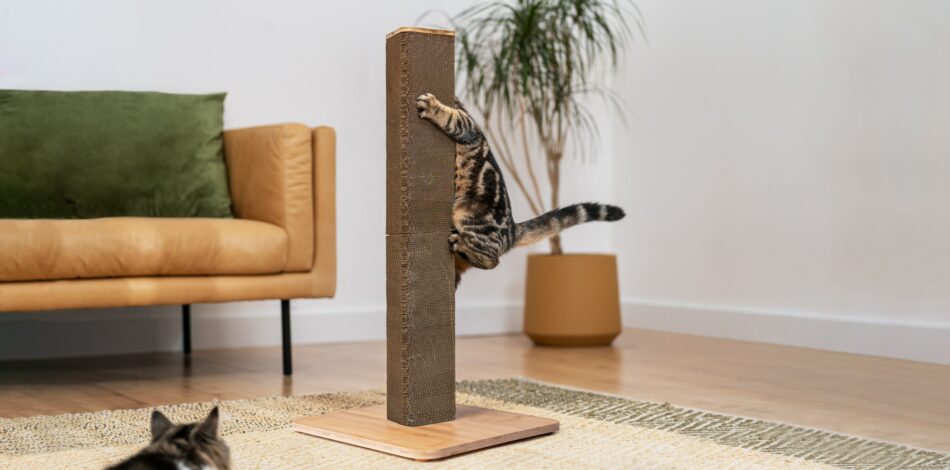
Cat owners around the world can agree the delightful snuggles and simple sweet gestures of their cats are what make the human-cat relationship so wonderful. But as much as we love our furry feline friends, their innate behavior to scratch – especially our carpet – is not so loveable. Cats scratch for several reasons, with owners often left scratching their heads as to how they can stop this destructive pastime. Thankfully, Omlet has all the information and products you need to help stop your cat from scratching your carpet.
4 Reasons your cat could be scratching your carpet
Scratching to cats is as essential as breathing – it’s just part of being a cat. So let’s take a look at all the reasons why your cat could be scratching your carpet.
- Scratching feels good: Think of your own daily routine. What are some things you do every day that make you feel good afterwards? Brushing your hair, washing your face, shaving your face? For cats, scratching is no different. The act of clawing feels good to cats and is a way for them to sharpen their claws.
- Scratching is a cat workout: Watch your cat the next time they are scratching your carpet, furniture or cat scratching post. Their front arms are moving back and forth while their back legs are mimicking squats we do in the gym. Pretty great exercise, huh?
- Scratch marks the spot: Did you know that cats have tiny scent glands all over their paws? And when they scratch, it’s a cat’s way of leaving their scent, or their mark, in a specific spot. So one reason they’re scratching your carpet is to leave a scent message to any other pets that this is their territory.
- Pay attention to me!: Sometimes the reason cats scratch carpet is for the same reason toddlers draw with crayons on the wall. They just want your attention! The act of scratching is a communication signal that they want you to look at them, pet them or just play with them.
Scratching the carpet near the door
If you find the carpet closest to the front door, back door or even your bedroom door is where your cat claws the most, there could be a few reasons why they chose this spot. You and your cat likely have a very close bond, but with that bond can sometimes come separation anxiety or kitty stress when you leave them to go out. In this instance, your cat is using scratching as a way for them to show their emotions. Fortunately, you can help them by giving your cat a specific spot to channel that stress with a durable cat scratching post such as the Stak cat scratcher from Omlet.
Another reason your cat may be clawing the carpet by the front or back door is because they’re looking for more space to explore and roam. While we have taken cats out of the wild through domestication, the wild sometimes remains within. And that “wild sense” is a need to explore. So give your cat what they want with an outdoor cat enclosure like the Catio designed by Omlet. When your cat knows they have more space to roam outdoors, they may be less likely to tear up the path leading there.
Why is my cat scratching the carpet at night?
Is your cat reserving their claws for your carpet only at night? Here are 3 reasons why your feline friend is up scratching all night and what you can do to help.
- Skin issues: Allergies, skin infections or even parasites are all problematic health issues that can affect your cat. And just like us, these irritable issues tend to become more present at night when we are focused more on resting. Always consult your veterinarian should you suspect any skin issue so you can get professional medical help to keep your cat feeling their best.
- Can’t get comfortable: Have you ever had a restless night (or nights!) of tossing and turning? Often, it’s because you can’t get comfortable in your bed. Well, the same can happen with your cat. Without a comfortable and supportive cat bed, your cat can be left feeling unsettled at night, which will inevitably lead to scratching away at your carpet.
- Feeling insecure: Just like babies and toddlers who wake up in the middle of the night looking for the security and comfort of their parents, cats can sometimes do the same. Only, instead of crying out for Mom or Dad, they just scratch the carpet. But fear not – you can help them! If you’re open to letting your kitty co-sleep, place a cat blanket on your bed so they can curl up next to you. Or, you can even give your cat a place all their own like the Maya Indoor cat house designed by Omlet for that added sense of security. Add a Maya Donut cat bed inside for extra comfort and support!
3 Top tips to stop your cat from scratching the carpet
Because scratching is essential to your cat’s health, you don’t want to stop this behavior altogether. So does that mean your carpets just have to stay frayed and destroyed? Not if you follow some of these tips which will help encourage your cat to take their scratching elsewhere.
- Redirection: The best way to stop your cat from scratching your carpet is to give them something else just as appealing to dig their claws into. And in order to do that you need to give your cat something more irresistible than your carpet. Enter catnip – one of your cat’s true loves. Just place some catnip in the places your cat can scratch and you will quickly redirect them away from your carpet.
- Scent spray: Cats have a very powerful sense of smell. And there are several scents that your cat will turn their nose away from as the smell is too displeasing to their sniffer. Simply spray a citrus, lavender, peppermint or lemongrass scent all over the carpet and your cat will take one sniff and search elsewhere for their scratching session.
- Clean carpets: Did you know cats have tiny scent glands all over their paws? And one reason they continue to scratch your carpet is because they can smell where they left off from their last scratch session. So the more you can keep your carpets cleaned and washed, the more you can encourage your cat’s scratching behavior elsewhere.
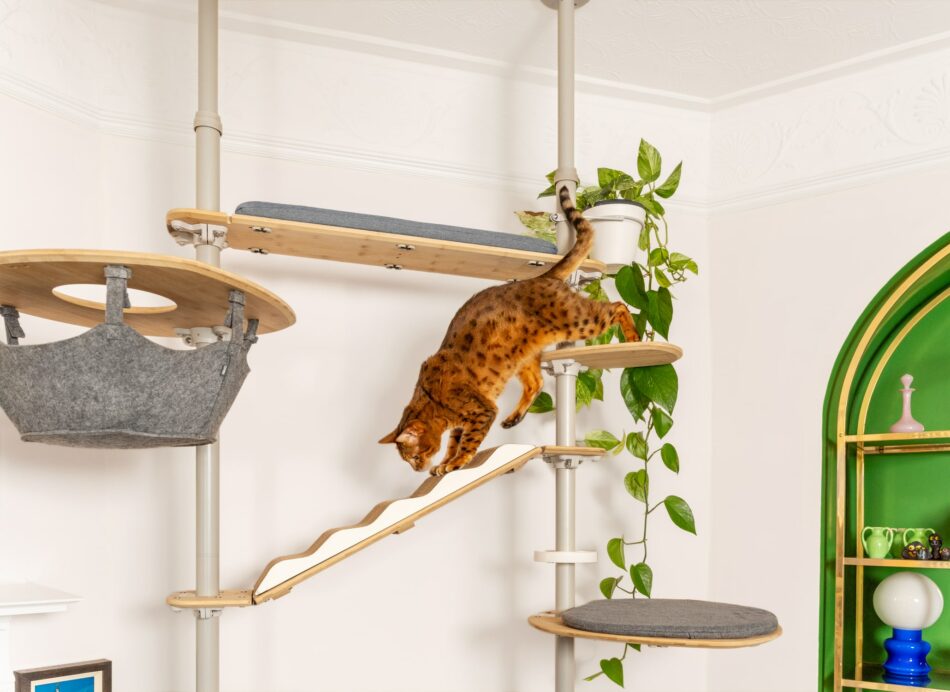
Encourage healthy scratching with a cat scratch post
While there are many ways you can try and stop your cat from scratching your carpet, there is no doubt that the best way to encourage healthy scratching is with a cat scratching post. The Stak cat scratching post designed by Omlet is the perfect post option because of its durable refillable cardboard and stylish supportive design.
Created with the innate instincts of cats in mind, we made the Stak cat scratcher to be the last scratcher you’ll ever buy. The hard-wearing cardboard will stand up to your cat’s many scratch sessions and when it does finally get worn down, you can recycle or compost the old and replace with a new refillable cardboard Stak. You can enjoy the sleek look and sustainability of the Stak cat scratcher while your cat enjoys doing what they love!
Cat scratching posts not only save your carpet from frays and tears, but they also add entertainment and enjoyment to your cat’s life. So why not take your cat’s enjoyment to the next level by adding to their cat scratching fun with a cat climbing tree and cat toys? With our wide range of cat tree accessories, your cat will be scratching their way to happiness all day, every day.
Carpet materials your cat won’t scratch
- Wool – it may be expensive, but this textile is desirable for you as cat claws are less likely to get into the piles and pull apart.
- Nylon fiber – a less expensive alternative to wool, this textile is much like wool in its durability and cat claw resistance.
- Tight weave – carpets that have tightly woven piles are less likely to get destroyed by the scratches of cats as compared to others
Keep watch for other scratching behavior
Have you noticed your cat scratching more than just your carpet? Are your sofa and walls getting the attention of your cat’s claws as well? It’s important to keep an eye out for exactly what your cat is scratching so you can not only limit the path of destruction, but know how to encourage better scratching habits as well.
If you find scratch marks on your wall, you can easily redirect your cat to something more desirable, such as a wall-mounted cat scratcher. And if the sofa or chair have become your cat’s latest scratch favorites, encourage them to keep scratching on something better like a cat scratch ramp attached to a cat climbing tower.
Caring for your cats with Omlet
Cats of all breeds and their natural behavior to scratch is a tale as old as time. At Omlet, we know this instinct cannot be stopped and, in fact, is one that should be encouraged in a healthy manner. And that is why we continue to challenge the pet norm and create products that allow your cat to be the best version of themselves while bringing you closer to them in the process. From durable cat scratching posts, to adventurous cat trees, to comfy cat beds, and mess-free kitty litter boxes, Omlet makes products that deliver happiness and ease to you and your cat.
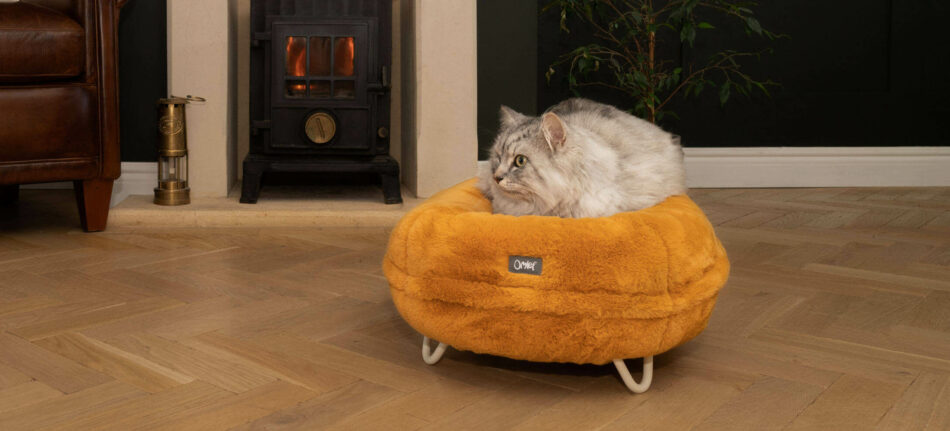

This entry was posted in Cats
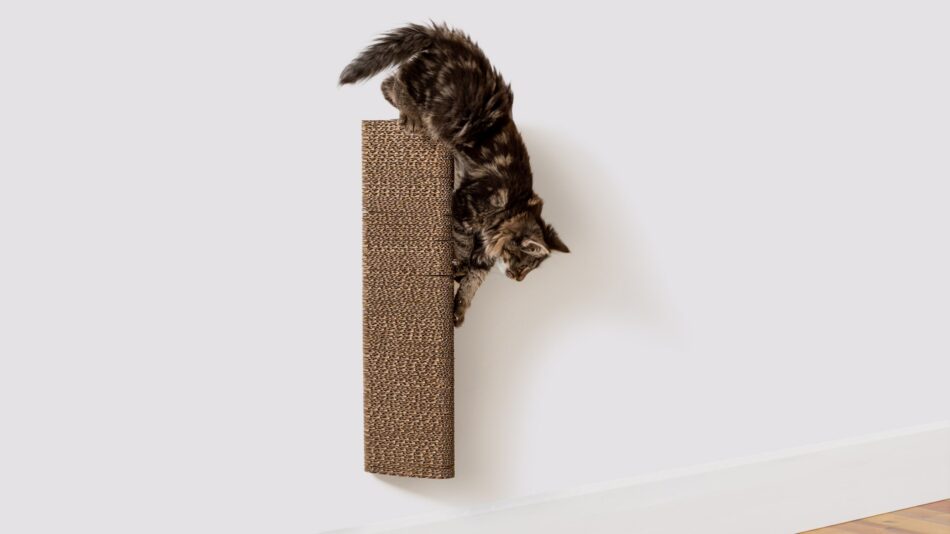
You love your cat and you love the home you live in with your cat. But what do you do when the cat you love is scratching the walls of the home you love? The simple answer is you can’t stop a natural feline behavior, but there are things you can do to redirect and retrain this instinct. Keep reading to get the tips, tricks and products to help stop your cat from scratching your walls.
Why is my cat scratching the walls?
When it comes to cats scratching furniture, we often think our furry friends direct this normal, yet destructive, behavior on things like the sofa or the carpet. So when the walls of your home look like they have been redecorated with lines and marks, you’re left scratching your head with frustration.
But the truth is all cat breeds scratch. So the best way to learn how to redirect this innate behavior is to better understand why they do it. And the answers are usually in the details. When you see your cat on their hind legs, stretched out in full scratch mode on your wall, it may remind you of an exercise move you’ve done yourself. But for cats, scratching is one of the key ways to move and exercise their bodies.
As well as for exercise, cats use scratching as a way to clean up their nails, burn off any stress and anxiety or simply just a way to cure boredom. For cats, the act of scratching feels good on their claws, paws and their bodies. But this doesn’t mean you’ll be stuck living with torn-up walls. With cat scratching posts such as the Stak Cat Scratcher, you can quickly get back to clean walls while your cat gets back to scratching.
2 reasons cats scratch walls after feeding time
Does your cat take to the walls after they’ve eaten dinner? There are two main reasons they’re exhibiting this specific behavior:
- Picky kitty: Your cat can’t talk, so if they have something to say they’ll do so with actions. And when it comes to cat food that they dislike or are bored of, that communication may come through in the form of scratching the walls after dinner. It’s kind of their way of saying, “Thanks, but no thanks.” So if you notice post-meal scratches, try and change up their cat food and see if that resolves the problem.
- Scratch marks the spot: Another reason your feline may fancy the walls after feasting is to let any other animals in the house know that this is their food and to stay away. Politely, of course. Cats use scratching as a way of marking territory and with tiny scent glands located on their paws, they can sometimes scratch around their food bowls to instinctively send a message that this feeding zone is off limits.
3 reasons cats scratch walls around their litter box
Most cats are bathroom ninjas. With stealth-like maneuvers, they quietly get in, get out and get on with their day without you ever noticing they used their cat litter box. So if you start hearing scratching noises coming from the litter box, there are a few explanations for why:
- The litter is full – Our cats are great companions but they’re also great communicators – if you know how to listen to their clues. So if you notice your cat suddenly scratching at the walls by their bathroom it could mean they’re telling you the litter box needs to be cleaned. A quick refresh of new cat litter should solve the problem and get your cat back to happy bathroom behavior.
- Feline flushing – In the wild, cats don’t have a litter box to ‘do their business’ in. But they know that ‘their business’ leaves a distinct scent, so in order to prevent predators from picking up their location, they scratch leaves and dirt to cover it up. And even though we have domesticated the wild out of the cats, that instinctual knowing remains, so cats will scratch at the litter to cover up ‘their business’ in the litter box.
- Perfect paws – What’s the first thing you do after using the bathroom? We hope your answer is “wash my hands”. Well, your cat likes to have the same level of hygiene. Often, cats will scratch the walls around the litter box as a way to clean their paws and remove any excess litter bits that get trapped between their toes.
One of the best ways to combat wall scratching by the litter box is to get your cat one that solves all these problems. With the Maya Litter Box, designed by Omlet, your cat not only gets a private potty retreat, but the easy-to-clean and anti-tracking liners make your job easier, too.
4 ways to stop your cat from scratching the walls
The fact is there’s no one surefire way to stop your cat from scratching the walls. But here are 4 ways we have uncovered that are sure to redirect your cat’s habits.
1. Install a wall-mounted scratcher
If you can’t stop your cat from scratching your walls, why not just give them what they want? Introducing the Stak wall-mounted cat scratcher, designed by Omlet. An ingenious design that meets your cat exactly where they are – at the wall.
Made from a durable cardboard that’s both recyclable and replaceable, your cat will be left satisfied after every scratch. And bonus – the sleek bamboo design makes this wall addition a welcomed upgrade to your cat and your interior.
2. Create new climbing spots
In addition to being natural scratchers, cats are also natural climbers. And when they aren’t given ways to explore these natural behaviors, they’ll inevitably turn to doing things you don’t like such as scratching walls, furniture and floors. One of the best ways you can curb your kitty’s scratching is with a climbing tower.
The Freestyle Indoor Cat Tree is the answer to every cat’s prayer as it provides all the fun and adventure they seek in one complete unit. Designed with your cat’s needs in mind, we engineered this cat tower to be completely customizable with a variety of different cat tree accessories so your cat can climb, scratch and snooze their way to happiness.
3. Give more attention and exercise
As cat owners, we know that life can get busy, and sometimes playtime with Kitty can get put on the back burner. But we also know that this lack of attention can lead to frustrating results, so it’s important to always pencil in some time each day for extra feline play.
To help stop your cat from scratching the walls, try giving them just a few more minutes each day of your undivided attention and see how their scratch time might turn into more snooze time. Even just a quick game of hide and see the cat toy will engage your furry friend enough to limit the destructive behavior and engage their need for attention and exercise.
4. Spray a citrus solution
Ahhh…the sweet summer scents of citrus. For humans, this smell is delightful and aromatic. But for cats, the smell of citrus is downright repulsive. So to stop your cat from scratching the walls – or any other surface or object – simply spray a citrus location all over and watch your cat give it the cold shoulder.
You can buy a premade solution from the store, or try concocting your own spray at home. Just fill a spray bottle with water, lemon juice and the peel of an orange to create a scent your cat won’t scratch.
Caring for your cat with Omlet
At Omlet, understanding your cat’s behaviors and natural instincts is part of our business. It’s how we challenge the pet care norm and create products that give your cat exactly what they need and what they want. From stylish and durable cat scratchers, to adventurous cat climbing towers and outdoor cat playgrounds, we’ve scratched every possible way to meet your cat’s needs. And when your cat is happy, you are happy and there really is no better feeling than that.
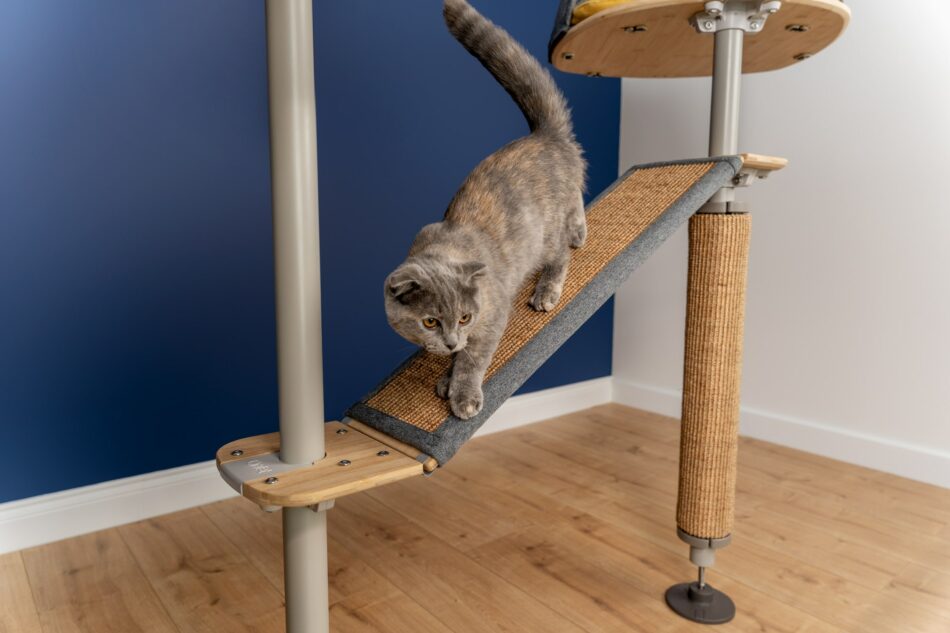

This entry was posted in Cats
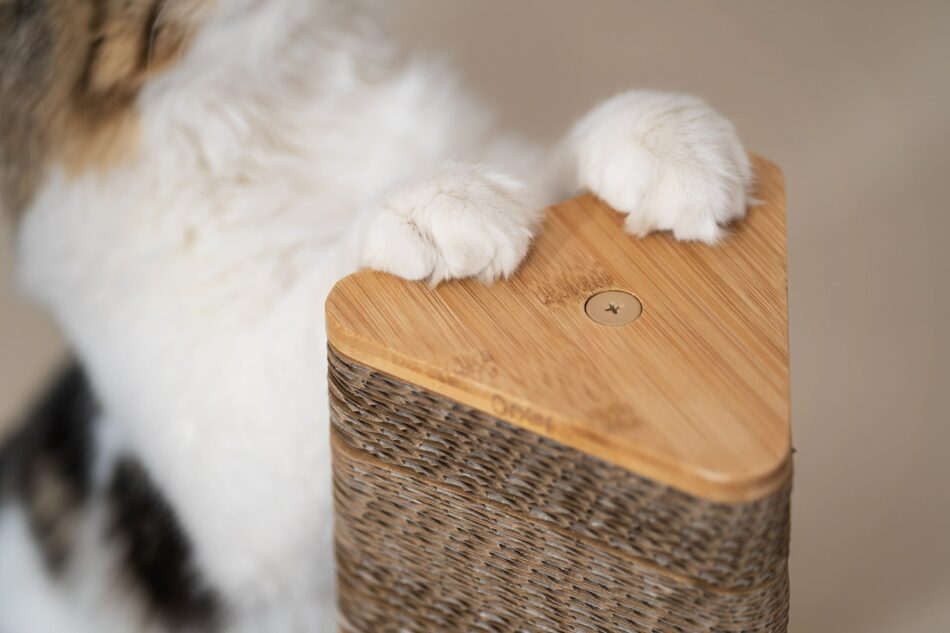
Have you ever carefully looked at your cat’s paws? They’re so soft and adorable, aren’t they? We know that cats use their paws to get around and hunt. But have you ever wondered if there’s more to the furry feet of your feline friend? From communication to grooming, to temperature regulators, cat paws actually have many interesting and important uses. Let’s dive into the fascinating world of cat paws and you’ll soon see that your feline’s feet are not only adorable, they’re also pretty amazing!
1. Cat paws are super shock absorbers
We’ve all heard the saying that cats always land on their feet. And while they are graceful jumpers, the paws they land on do more than just steady their body. The pads on a cat’s paws are actually mini shock absorbers. A soft cushioning of skin surrounds the bottom of your cat’s feet, allowing them to land softer and silently. This is one of the reasons why cats are such good hunters – their prey never hears them coming.
Giving your cat the ability to utilize these tiny shock absorbers aids in their development and natural ability to climb, jump, scratch and play. The Freestyle Indoor Cat Tree takes cat climbing towers to the next level, giving your cat the chance to exercise their natural abilities and pounce away on their soft, silent paws.
2. Cat paws have more in the front, less in the back
‘Hemmingway cats’ are famously known for having one extra toe than that of other cat breeds. But did you know that ALL cats have more toes on their front paws than on their back paws? With the exception of the unique American Polydactyl breed (aka Hemmingway cats), all cats have 5 toes on their front feet and only 4 on their hind.
The extra toes on each front paw are actually called “dew claws”, which are a little like thumbs for kitty paws. These extra toes can aid in a cat’s natural hunting ability, however, because they’re located higher up on the paw, they don’t wear down as fast as the others. So make sure your cat has a sturdy and durable cat scratcher to help manicure all their claws.
3. Cat paws are sensor communicators
What if your cat could know you were walking in the room before they saw you? Well, they actually can! Cat paws are covered in tiny little nerve receptors that act as a sensing communication hub for your cat. These small sensory receptors can feel the smallest of vibrations or pressures emanating from the ground and, in turn, alert your cat to surrounding movement. In the wild, this 6th sense is super beneficial to help cats keep away from predators or danger. But as our domesticated feline friends, it’s really just a good signal that it’s time to curl up with a cozy cat blanket and you, their favorite human.
4. Cat paws are temperature regulators
As humans, we regulate our body temperatures through the numerous sweat glands all over our bodies. But have you ever thought about how a cat can cool down? Our feline friends are covered in fur so where exactly are their sweat glands? You guessed it – on their paws. Cats have small sweat glands on the pads of their paws that work to help cool them down naturally on hot and humid days.
While these glands are good at helping to cool off, it’s still important to make sure your cat always has enough water and shade on hot days to aid with temperature control. And if your cat is an indoor cat that spends some time outside, make sure you have a safe outdoor cat enclosure for them to enjoy their outdoor playtime in. You can even add Omlet Catio covers on top to provide shade and protection from inclement weather.
5. Cat paws have color
Bet you didn’t know it, but cats are the original true fashionistas. That’s right! The color of a cat’s paw pad actually matches the color of their fur or nose. For example, ginger-coloured cats have pinkish colored paw pads, black cats have black colored paw pads and tuxedo cats have a mix of white and black colored paw pads. Interestingly, multi-colored cats like the Calico, usually have multi-colored paw pads as well. Have you checked the color of your kitty’s paws yet?
6. Cat paws are built-in groomers
One thing cats are very good at is personal hygiene. If you’ve ever watched a cat groom themself, you have seen them use their paws as tiny scrubbers to clean around their face and ears. Most cats will first lick their paws to activate the rough pads with moisture and then they will gently rub their paws over their eyes, nose or ears in a circular motion to get everything clean. The Freestyle Cat Tree Accessories, like the cushioned cat tree step or cat tree hammock, make great grooming spots for your cat to clean themselves in comfort and ease.
While cats can take care of their personal hygiene, they may need some assistance with their claws if they remain indoors most of the time. Did you know that cat’s claws continue to grow throughout their life just like humans? For cats that spend their lives predominantly outside, these claws are kept short by natural behaviors, such as scratching trees and rough surfaces. So, for your indoor cat, be sure they have a strong and durable indoor cat scratcher or, better yet, opt for an outdoor cat enclosure so they can act out their innate instincts safely.
7. Cats have a dominant paw
Are you a righty or a lefty? While this is a common question to ask of humans, it can actually be a good question to ask of your cat as well. It may come as a surprise, but cats do have a dominant paw just as we humans have a dominant hand. There has been lots of research conducted to try and see if there is a rhyme or reason why certain cats prefer one paw over the other, but nothing conclusive has been determined.
So how do you know which paw is your cat’s dominant paw? Try this test. Get one of their favorite cat toys and put it in a hard-to-reach place from your cat. Each time your cat tries to swat, scratch or grab the toy, pay close attention to which paw they use first. Most likely that’s your cat’s dominant paw.
Take care of your cat with Omlet
At Omlet, we let the curiosity and the natural instincts of cats guide us in our creation of new cat products. We are constantly questioning how and what cats would want and answering those questions with solutions your cat will love. When it comes to cat paws, we offer a wide range of products that appeal to the specific behaviors and needs of your feline friend and their feet. Explore our cat trees, Catios, cat beds for ways to encourage your cat’s adventurous spirit and help them to explore and enjoy their surroundings. You may find you notice more of your cat’s paw power than ever before.
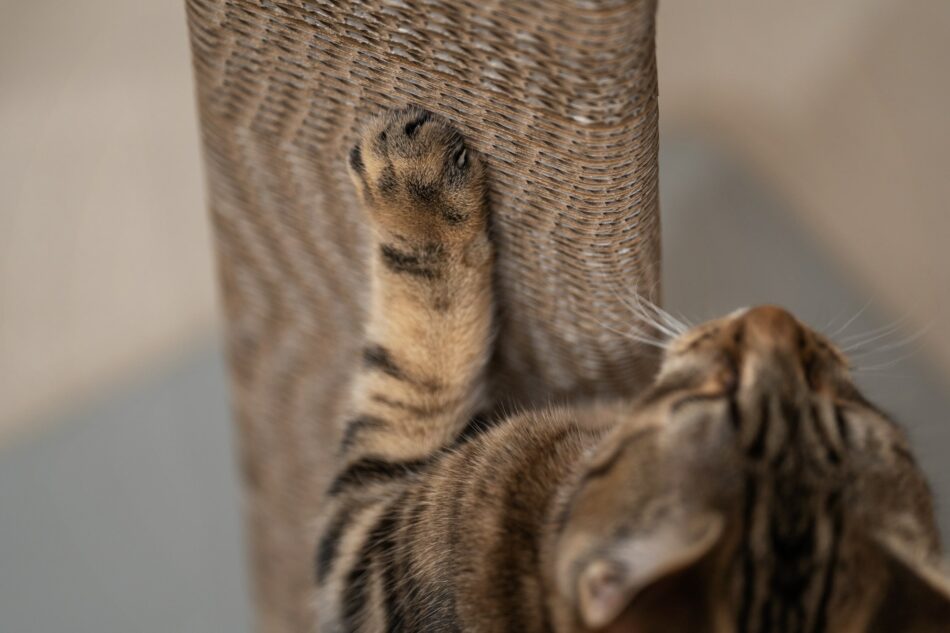
This entry was posted in Cats
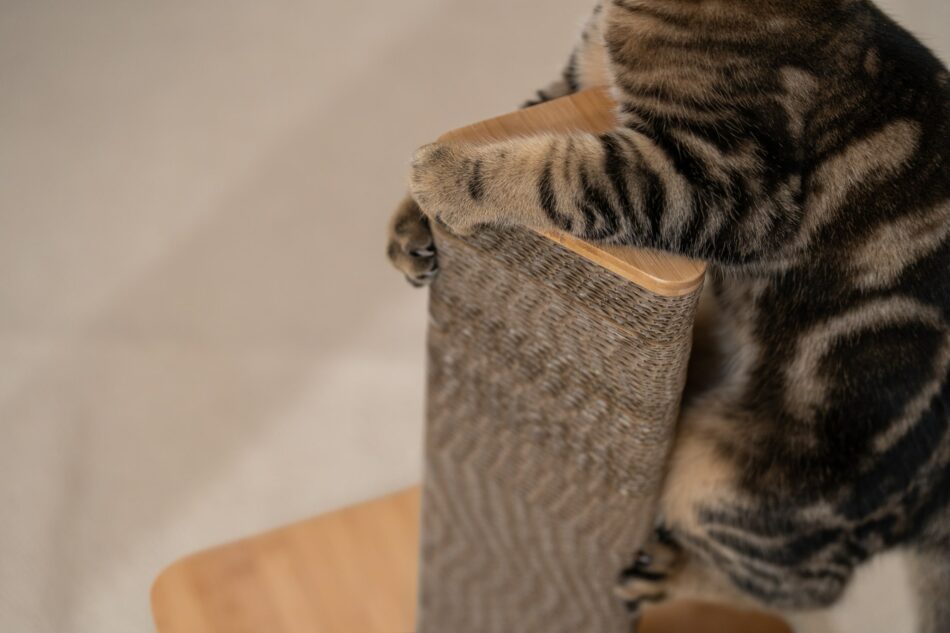
Owning a cat can bring so many wonderful experiences into your life. Like unconditional love, true companionship and the constant scratching of your furniture. But what if you want the first two experiences and not the last? How do you keep your cat from scratching on your furniture?
Well, you can’t stop a cat from doing what it’s made to do. Scratching is to cats like walking upright is to humans. But there is some good news. While you can’t stop your cat from acting on their innate behavior, there are several things you can do to keep them from scratching up your furniture.
Read on to learn some tips and tricks on how you can help your cat continue to be a cat and keep your couch looking like a couch.
3 reasons why cats scratch furniture
There are three main reasons why cats like to scratch. Born as a primal instinct, cats use scratching for both their health and territorial surroundings. Let’s have a closer look at why cats scratch on furniture:
- To keep nails sharp.
In the wild, cats scratch on trees and other hard surfaces as a way of giving themselves a manicure. Yes, cat’s like to have trimmed and pretty nails, too! The act of scratching actually removes the dead layers of the claws, allowing for the nails to stay sharp and ready for the next hunt, also known as “stropping”. - To mark their territory.
If you have multiple cats, you may notice that they have specific areas that each cat likes to scratch. That’s because cats mark their territory every time they use their claws. With tiny scent glands that cover a cat’s paw, they spread their specific smell with each scratch letting other felines know that they have claimed that couch, chair or cat scratching post as their own. - To exercise.
A scratch a day keeps the sore muscles away! Did you know that cats use scratching as a form of exercise? It’s true. Next time you see your cat on their hind legs, moving their arms back and forth in a scratching motion, imagine doing that same movement yourself. Quite the workout, isn’t it?
Are certain feline breeds more likely to scratch?
All cats scratch. Period. While certain cat breeds exhibit different behaviors than others, scratching is the one characteristic trait that remains universal. However, there are a few select breeds that can be more easily trained to stop scratching your furniture. So if you’re looking to get a cat that is more likely to lay on your couch than scratch it, here are 3 breeds to consider:
- Scottish Fold: Considered an extremely endearing and affectionate breed, Scottish Fold cats love to spend time with their people. And because they respond so well to positive reinforcement and treats, they’re easily trained when it comes to not scratching up your furniture.
- Ragdoll: The famed Ragdoll cat gets its name from their docile and lap-loving temperament. This breed tends to be very passive and, as a result, less likely to exhibit destructive scratching behaviors.
- Persians: Known as the calm and quiet ones, Persians make great house cats as they love to be loved, give love and to be left alone in peace and quiet. Because this breed is not an anxious or overtly exploring type, they typically spend more time sleeping and less time scratching.
Tips to stop your cat from scratching furniture
Stopping your cat from scratching your furniture is kind of like stopping your toddler from drawing with crayons all over the house. It’s less about stopping the behavior, and more about finding ways to redirect or harness it. Let’s take a closer look at some of your feline’s favorite furniture pieces to scratch and how you can keep them off of it.
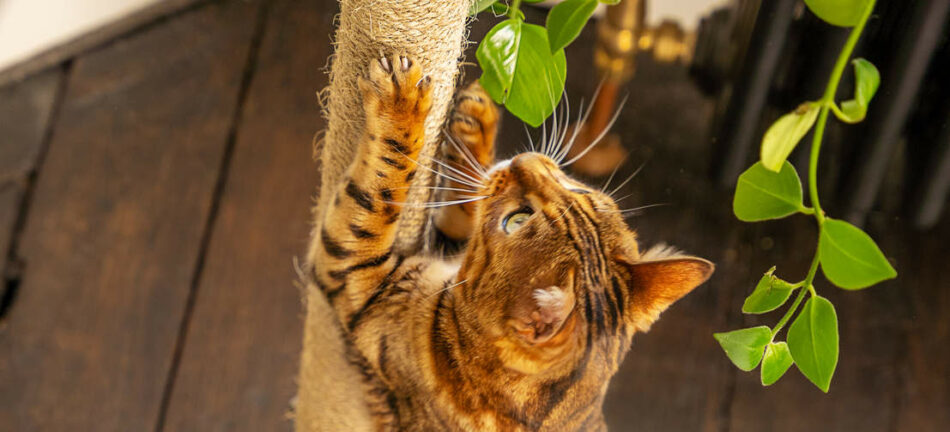
Couch surfing, not couch scratching
So you just bought a beautiful new couch that you are excited to snuggle with your cat on but, instead, they think it’s a beautiful new scratching post. Fear not – there are options. You could try and stop the cat scratching altogether. But since we’ve already discovered that’s a near-impossible task, stop your cat from scratching your couch by redirecting their scratching to something else.
The Omlet Stak Cardboard Scratching Post is a great option to redirect couch scratching as it mimics everything your cat is looking for in a scratch experience. Designed on a vertical and sturdy frame, it’s tall like a couch to give your cat that ‘stand up to scratch’ feeling. The durable cardboard also resembles the strength of couch fabric so your cat will easily make the switch in no time.
Carpet is for walking, not scratching
Does your carpet have lots of frays from your feline friend? Chances are this means your cat prefers scratching on horizontal surfaces over vertical. So why not give your kitty what they want? By simply placing a horizontal wave cat scratcher by their cat bed, you can encourage your cat to have a more personalized scratching session and avoid scratching the carpet altogether. Now everyone is happy.
Wall scratching be gone
The walls in your home should be adorned with pictures of your pretty kitty – not with marks from their claws. So what do you do if your cat likes to scratch at your walls? Before you go out to get more paint from the store, consider this option. Most cats that scratch walls do so because they like the support from the sturdy wall while they file their nails.
So what if you could just specify one part of the wall as their territory? With the Omlet Stak Wall Mounted cat scratcher, you can! Give your cat the scratching experience they desire in a way that benefits them and your home. Simply mount the wall cat scratcher and let your cat discover a new way to enjoy a vertical scratch.
How Omlet Cat scratching posts encourage healthy habits
When it comes to catering to your cat’s natural behaviors, Omlet has you covered. One of the main reasons cats scratch anything is because it makes them feel good. That’s precisely why we challenged the norm when it came to our cat scratcher designs to provide a unique experience for your cat that also delivers healthy habits within your home.
Regular cat scratchers can be worn away quickly and when that happens, cats are more likely to move to the couch or the carpet to keep up the scratch. With the Stak Cat Scratcher designed by Omlet, the worn-away cardboard layers can be replaced with new refillable layers so your cat will always enjoy a feel-good scratch on their scratching post, and not your furniture.
We also know that cats have more interests than just scratching. With the Omlet Freestyle Indoor Cat Tree, you will not only give your cat the gift of scratching, but by incorporating our hammocks, steps and platforms, you will also better enable your cat’s curiosities. And don’t forget to keep lots of cat toys around so you can engage and better connect with your cat anytime.
Caring for your cat with Omlet
The beauty and wonder of cats is in the unique and interesting behaviors they possess. When you better understand them, as Omlet does, you can better suit their needs with products that matter. From indoor cat scratchers, to outdoor cat playgrounds, to snuggly cat beds and every cat product in between, we have what you need to satisfy your cat’s senses. Let Omlet keep your cat busy so you can keep your furniture looking good!
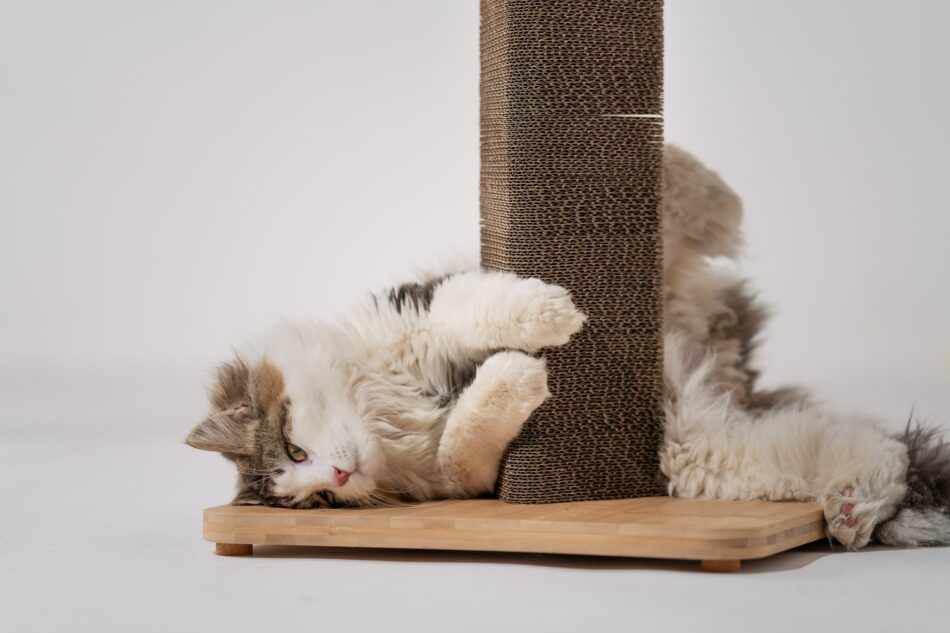
This entry was posted in Cats
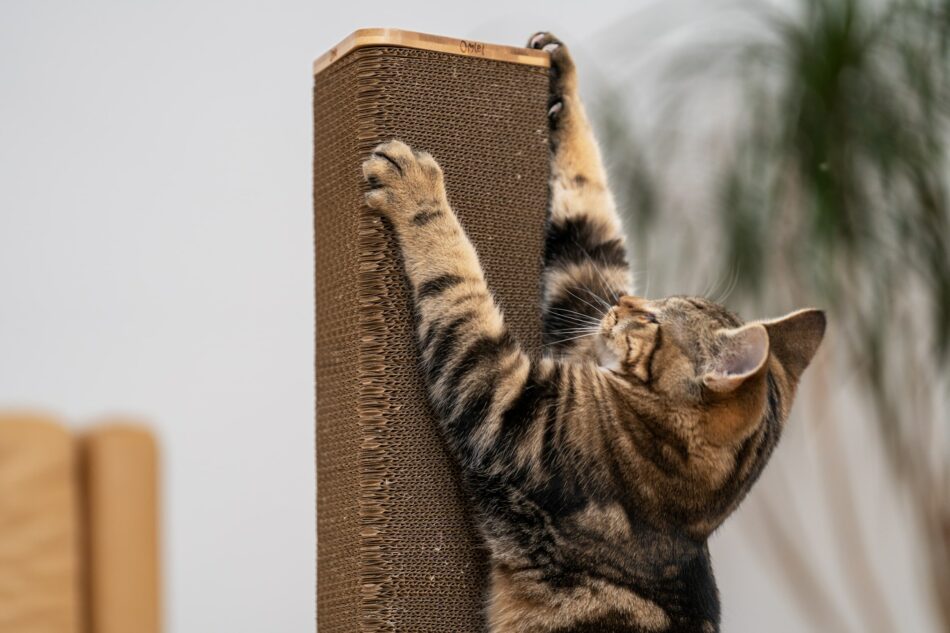
As consumers, humans are becoming more mindful of the products we purchase to ensure they are better for the planet. But did you know that your cat is a consumer, too? While they don’t go to the store and buy what they need, cats – by way of humans – do in fact have their own carbon foot(paw)prints. But fear not! There are many small – and simple – actions you can take to reduce your cat’s carbon pawprint and live a more sustainable life alongside you.
Many of the items that your cat uses such as toys, litter and even food can be produced in ways that are harmful to our environment. So let’s have a look at some sustainable swaps you can make to help reduce your cat’s carbon pawprint.
Can a cat scratcher be sustainable?
When you think of cats, you can’t help but think of cat scratchers. Because scratching is an innate natural behavior for our feline friends, it’s imperative that you have a good quality cat scratcher for them to use for their mental and physical health. But is it possible for a cat scratcher to be sustainable?
A quick search on the internet will reveal a wide range of different cat scratcher options, all made from a wide range of different materials. From carpet to sisal to cardboard and many other materials, you’ll find yourself scratching your head over all the choices. So how do you know which cat scratcher is good for your cat and the environment?
At Omlet, we recognized that not all cat scratchers are made the same. While some may look good, the materials they are made with are not recyclable, meaning those scratching posts will end up finding a new home in landfill before too long. Which means they’re not good for the environment.
So, we set out to create a product that your cat will not only love, but is also good for the planet. The Stak Cardboard cat scratcher is a sustainable cat scratcher that’s made of refillable cardboard layers that are 100% recyclable and compostable. Your cat can enjoy a sturdy and stylish scratching experience and you can feel good about having a product that will withstand your cat’s scratch habits.
Eco-friendly kitty litter
Another way you can help reduce your cat’s carbon pawprint is through the cat litter choices you make for them. We know that cats can be quite particular about a lot of things – including their kitty litter – so you have to take yourself, your furry friend and the environment into consideration when choosing which is best. Thankfully, Omlet has many litter choices that your cat will love.
The two most popular formulas for cat litter are clay cat litter and pine cat litter. While both have specific properties that are good for reducing smells and odors, not all cat litters are good at reducing your cat’s carbon pawprint. Omlet’s wide range of cat litter offers options covering low waste and natural scents that eliminate bad smells and reduce your cat’s carbon pawprint at the same time. Who knew your cat’s bathroom experience could be so sustainable?
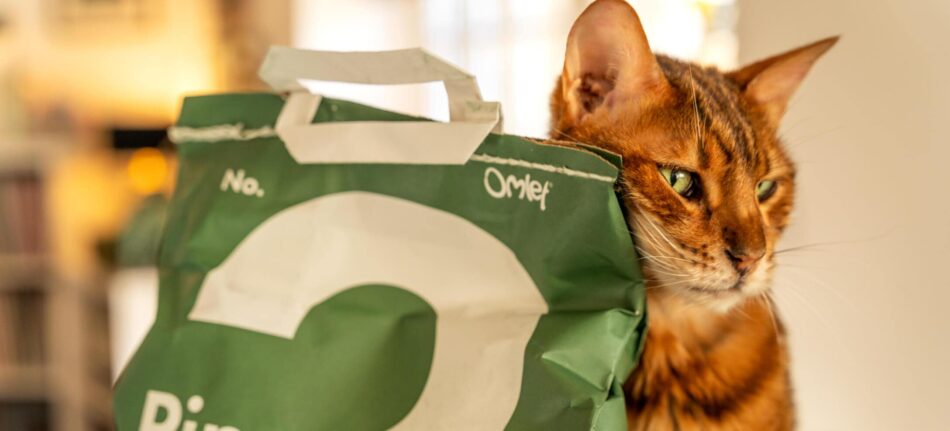
Invest in long-lasting cat toys
Do you ever play hide and go seek the toy with your cat? Engaging in fun and stimulating playtime with your cat is not only essential to their mental and physical well-being, but it is super beneficial to the bond you form with your feline as well.
Just like other non-recyclable products we consume, when they have run their course of use, where do they usually end up? That’s right, in the landfill. And in order to do our part as consumers for our cats, we can take simple steps to be more eco-friendly by buying long-lasting products instead. Made from high-quality materials, the Omlet cat toys are designed to withstand the constant pawing and pouncing of your kitty for a long time. Which means less waste for you and more fun for your feline.
Omlet and your cat’s carbon pawprint
At Omlet, our mission is simple. Design pet products that deliver to the needs and wants of your pet while connecting you closer to them. The bond between human and animal is such a wondrous connection and we believe making our products sustainable doesn’t compromise that relationship. Our line of sustainable cat scratchers, low-waste cat litter, and long-lasting cat toys are just a few of the ways we are giving your cat what they need while also giving back to the planet.
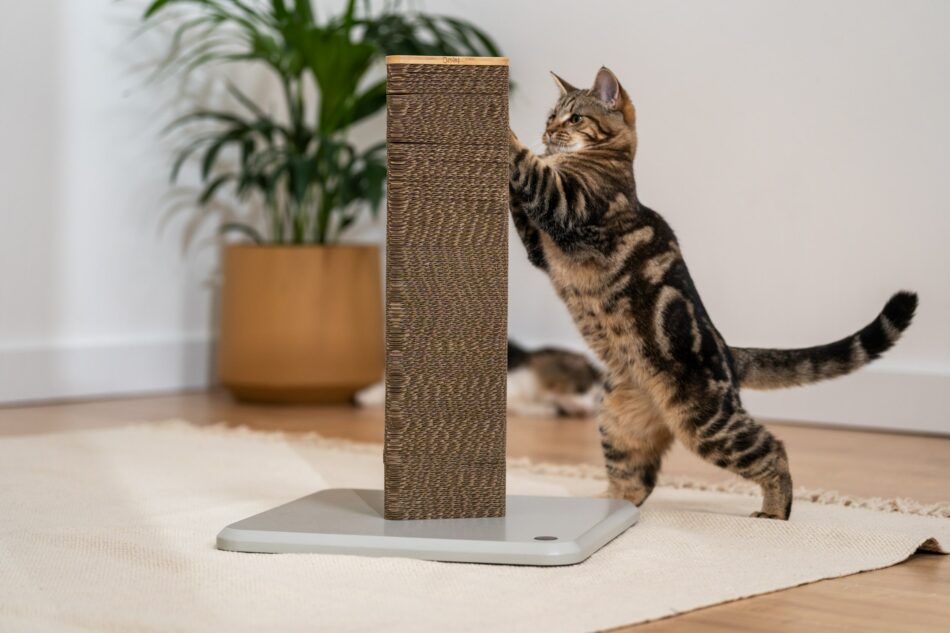
This entry was posted in Cats
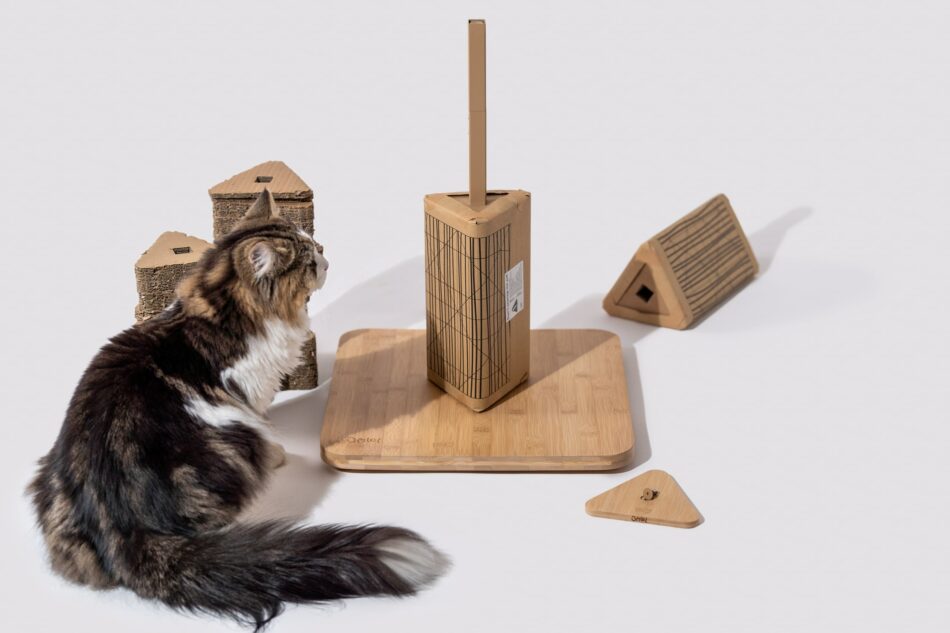
All cat owners agree that when it comes to our feline friends, only the best products will do. We love our furry tail-swishing friends and part of showing them that true love is through the products we buy them. But what makes something the best when it comes to products for cats?
At Omlet, we believe durability, longevity and ultimate support and comfort are just a few of the key ingredients to making a cat product that is best in class. We engineer our products to save you the hassle of buying over and over again so both you and your cat can enjoy them for a lifetime. So let’s take a look at some of the best products for cats designed by Omlet.
Cat beds
Cats like to sleep. A lot. So when it comes to finding a cat bed that’s the best for your furry friend, you want to make sure it’s not only supportive and comfortable, but practical and stylish, too. Meet the Maya Donut cat bed designed by Omlet – the best cat bed you can buy for your feline.
Give your cat a sleep upgrade with this premium faux luxurious cat bed. Designed with a unique donut shape cushioning, we engineered this dreamy bed to deliver first-class comfort to cats who deserve the best. The squishy marshmallow feel and soft cuddly cover provide both comfort and support to any cat’s body, regardless of age or breed.
But what makes this cat bed even better are the customizations you can choose, specific to your kitty. Available in 15 stylish colors, you can design the Maya Donut cat bed to match both your cat’s personality and your interior design. And the best part? Every cover is removable and machine washable so it’s easy for you to clean.
With the Maya Donut cat bed, you can also elevate catnaps with optional designer feet. By raising your cat’s bed, airflow underneath your cat is increased which, in turn, benefits your cat’s health and well-being. Plus, adding designer feet will make your cat’s bed look like another beautiful piece of furniture in your home.
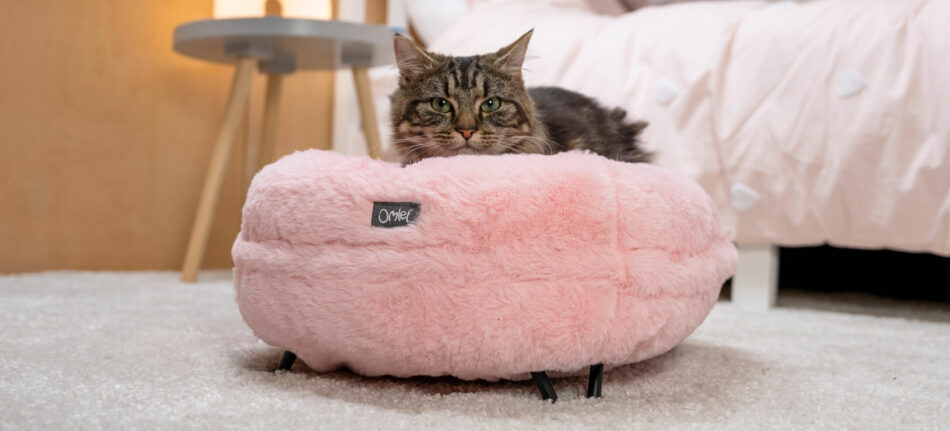
Cat litter furniture
When we set out to design the best cat litter furniture box, we looked at our own bathroom experience as a guide. If humans can use the bathroom in privacy, why can’t our cats have privacy as well? Enter the Maya Cat Litter Box Furniture – a sleek furniture-style litter domain that gives your cat a secluded bathroom experience while effectively minimizing the smells and messes in your home.
At Omlet, we believe that in order for a litter box to be the best, it must be high-quality in design, hygiene and discretion. That’s precisely why we designed the Maya Cat Litter Furniture to offer a range of entry points and styles to suit all cats. Senior and disabled cats will enjoy the side entry point for easy access and you will love the anti-tracking platform of the top entry box for your active kittens and cats. In addition, each box comes with a durable, long-lasting litter liner and activated carbon filter so that odors are absorbed and messes are easy to clean.
But to truly make a cat litter box the best, privacy to do cat business behind closed doors is the most important. The Maya Cat Litter Furniture offers your cat the ultimate bathroom seclusion with its smooth swinging door that creates a smell barrier with ventilation while also giving your cat a sense of privacy at the same time. Top off the box with high-quality cat litter designed by Omlet to ensure your cat’s bathroom experience is the best of the best.
Catios
What do you get when you put a cat on an outdoor patio? A catio, of course! As the brand that is continuing to pave the way for happier pets and people, we challenged the standard wooden frame outdoor cat enclosures to design a product that was better for you and your cat.
The Omlet Catio is a spacious and secure outdoor cat space that provides enrichment and exercise for your kitty while they safely explore nature. Born from the notion that cats are curious and adventurous, we designed an enclosure that allows them the freedom to seek out new spaces while safely being protected from any possible dangers or predators.
Constructed from heavy-duty steel welded mesh, the Omlet Catio is the safest and easiest to assemble outdoor cat enclosure on the market. The modular design allows you to customize the size of your enclosure to suit your backyard space with the ability to expand at any time. Perfect for indoor or outdoor cats alike, the Omlet Catio is not only the best product for your cat to enjoy more of nature, but a perfect space for you to connect with your furry feline friend as well.
Cat scratching posts
What’s one trait that all cats have in common? They all love to scratch. And if you’re like us, you want to enable this innate feline behavior – just not on your furniture. As pet owners ourselves, we, too, have cat scratchers for our kitties but we got sick and tired of throwing them away after they were worn down. Not only is it expensive to buy new ones every few months, but cat scratchers ending up in a landfill is not good for the environment.
So we asked if there was a way for a cat scratcher to live forever? And our answer to this question has arrived in the form of the Stak cat scratcher. Designed with replaceable cardboard layers that can be recycled or composted when worn away, the Stak cat scratcher is sustainable and eco-friendly. Aka the last cat scratcher you’ll ever buy.
Available in different sizes as well as freestanding and wall-mounted options, we created this cat scratcher with your cat’s natural behaviors in mind. When the cardboard is worn away from numerous fun, feel-good scratch sessions, simply recycle the old layers and replace with a new refill of cardboard. With the Stak cat scratcher, you can feel good about giving your cat the best scratching experience while also giving back to the planet.
Cat climbing frames
When it comes to climbing, cats are the experts of heights. In the wild, cats climb trees or other objects as a way to escape predators and also observe their surroundings. But do indoor cats like to climb cat trees? At Omlet, we believe they do.
But in order for us to make a cat tree that was best in class we had to challenge our engineers to think outside the traditional all-in-one cat trees. You know, the ones that take up a lot of space, become smelly and useless when worn down and often end up in a landfill as a result. Our mission was to create a cat tree that was high-quality and sustainable yet also customizable to allow for more interactions and bonding between you and your beloved furry friend.
The Omlet Freestyle Cat Tree is truly an innovative and unique product that delivers these attributes and more. Designed for all cats, regardless of age or breed, the Freestyle is engineered as a space-efficient, customizable adventure tower that provides your cat with endless hours of mental and physical stimulation. Choose from a variety of accessories like the hammocks, steps and ramps to create the best cat tree that your cat could ever climb.
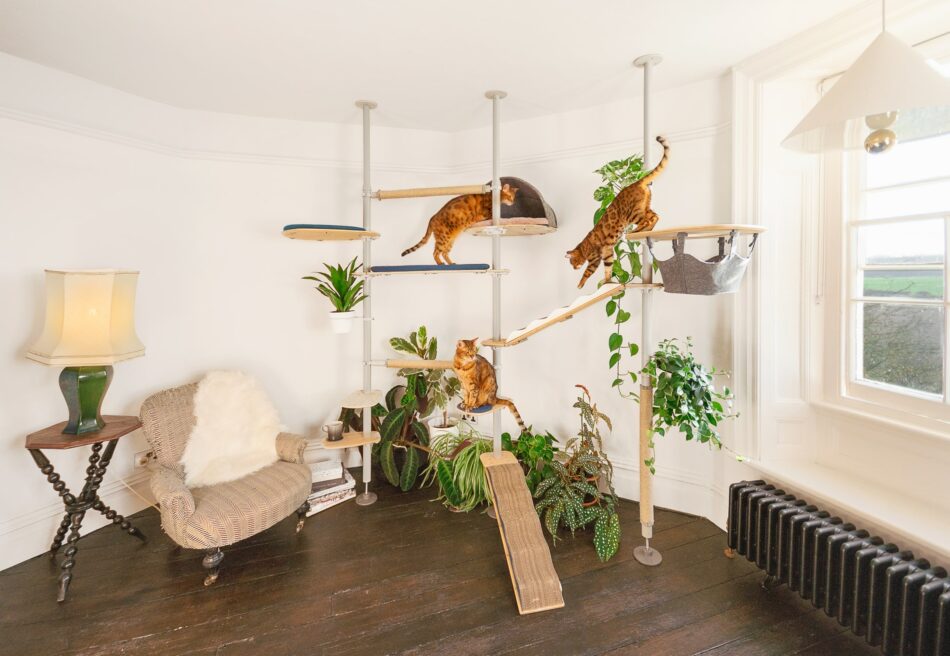
Cat toys
There really is no time like playtime with your cat! Both an engaging and bonding activity, playing with your cat brings happiness to you both. And one of the best ways to engage your feline friend in play is with cat toys.
That’s why we designed our Omlet cat toys to keep your cat physically and mentally engaged for hours. Our unique sea-inspired designs are carefully made both with and without catnip as we know some kitties love catnip more than others. Keep your cat entertained with these unique and best-in-class cat toys!
Omlet and your cat
The connection you have with your cat is a wondrous thing and we believe that bond should be celebrated in the products you use. As the pet company that is constantly challenging the norms to bring the best to you and your pet, our designs are the highest quality products available on the market. From the stylish and comfortable designs of the Maya Donut cat bed to creating the custom adventures that your cat craves in the Freestyle cat tree to the sustainability of the Stak cat scratcher that reduces waste, Omlet has every best in class product that your cat needs.
This entry was posted in Cats
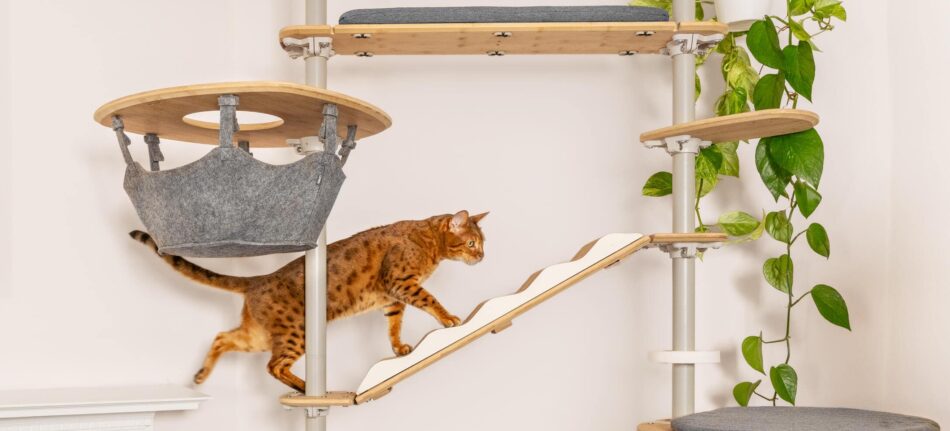
Chances are if you’re looking for your furry feline somewhere in the house, it’s likely your cat’s climbed up to an elevated location. Be it a bookshelf, the counter or the back of the sofa, the act of scaling heights is a very natural cat behavior that’s a crucial part of their everyday life.
But why do cats need to climb? Is it for fun or just part of their function? Or is it both? We explored all the reasons why cats climb and discovered how it makes them feel. Let’s jump in (or up!) to learn more.
Why do cats climb?
In the wild, cats are both predators and prey. As hunters, they instinctively seek out higher levels to view their surroundings and assess their environments. In order to enact the famous cat pounce, they have to be able to see what they’re pouncing on. And what better way to get that viewpoint than from higher ground?
But climbing up higher not only allows cats the ability to see their surroundings better, it also elevates their safety from being hunted by something larger. If you were being chased through a forest full of trees by something bigger than you, what would you do? Our guess is you would act like a cat and climb a tree for safety. Great thinking!
As domesticated pets, however, a cat’s instinct to explore and feel safe at higher heights does not just go away because they are no longer predators or prey. So how can you still play to your cat’s instincts without having a forest in your living room? How about by planting (or placing) an indoor cat climbing tree for them to use. Encouraging your cat’s natural behaviors is one of the most natural things you can do as a pet parent. After all, climbing is not only instinctual for cats, it is stimulating as well.
Do all cats climb?
The short answer to this question is, yes. However, while all cats CAN climb, not all cats LIKE to climb. While the urge to hunt, seek, explore and hide is prevalent in every cat breed, some cats are more prone to loving that urge from higher places than others.
Take Persian and Ragdoll breeds, for example. Equipped with shorter bodies on top of shorter legs, these cats prefer to keep their active play on the ground as it’s easier on their smaller frames. Whereas Abyssian and Siamese breeds satisfy their need to play and explore by climbing and jumping as much as possible. When it comes to cats and climbing, natural body types play a big role.
But regardless of breed or age, if you have a cat, you must have a cat tree to go along with them. The Freestyle Indoor Cat Tree designed by Omlet is a great option as it is completely customizable to your cat’s specific needs and desires. Have more than one cat in your family? Increase their territory with more vertical space by adding cat tree accessories like hammocks, platforms and scratching posts. You will not only engage their senses more, but you’ll also help save your furniture in the process!
How to encourage your cat to use a cat tree?
If you’re a first-time cat tree owner, congratulations! You have given your cat the gift of adventure and delight all in one item. And while it’s a given that all cats love a good cat tree, some cats have personalities that may require more encouragement than others to embrace it straight away. Here are some tips on how you can help your cat love their cat tree:
- Slow and steady: Cats are curious by nature and it’s our job as pet parents to help them be cautious as well. So if you’re introducing your cat to a cat tree for the first time, try using treats and cat toys as tools to help encourage them. Anything with catnip is guaranteed to get them going!
- Start low: One of the best features of the Freestyle Cat Tree is the ability to truly customize the setup and adjust accordingly. For cats that are just learning the cat tree ropes, start by placing the platforms and hammocks down low so they can ease into it. As they get more comfortable with the accessories, you can move them higher up so they can explore from different angles.
- Expand with ease: Your indoor cat will soon love the freedom they experience on their cat tree. So continue to expand their ability to lounge, scratch, nap and play by adding new accessories or poles. Feeling like your cat needs even more space? Try an outdoor cat tree on for size and watch your kitten get smitten by all they can see. Just be sure you enclose the cat tree securely with an outdoor cat enclosure so they can safely enjoy their new outdoor playground!
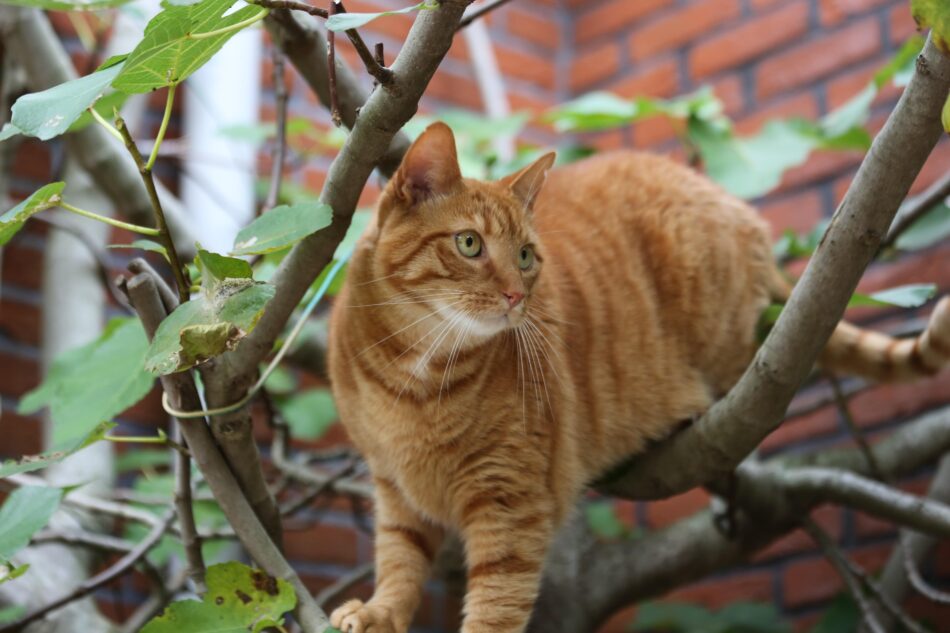
Cat climbing safety
We want our cats to stay healthy and safe at all times and climbing on a cat tree, or any object for that matter, is no exception. So how can you make sure your cat stays safe when climbing?
The first rule of thumb is to rely on their natural instincts. Have faith that your cat was born with the innate knowledge and ability to scale tall objects. Your part is making sure you provide them with the right tools for the job.
For kittens and senior cats, we recommend cat trees with adjustable accessories so you can move them closer to the ground. Both of these ages are prone to injury more than others, so you want to cater to their specific needs and keep their heights to a minimum.
It’s also important that you place your cat tree in an area of the home that is out of the way of other pets or children so you can be sure everyone, including your cat, stays safe. Make sure you secure the cat tree properly so your cat can confidently climb and jump without fear of falling over.
Finally, we suggest using sustainable materials for all your cat products so that you can ensure you are giving both your cat and the environment the best care. Products such as engineered cardboard or sisal cat scratching ramps are great options as they are not only durable enough for cat scratching nails but are also clean products to have in your home.
How Omlet helps your cat’s natural instincts
As the pet company that creates based on our research of animals’ natural behaviors, Omlet continues to incorporate these essentials into all of our products and designs. Our expertly crafted cat trees and accessories are engineered with every instinct to explore, jump, nap and play in mind. And when your cat is finished with a fun adventure of climbing, be sure they have a cozy cat bed to rest on to help them unwind.
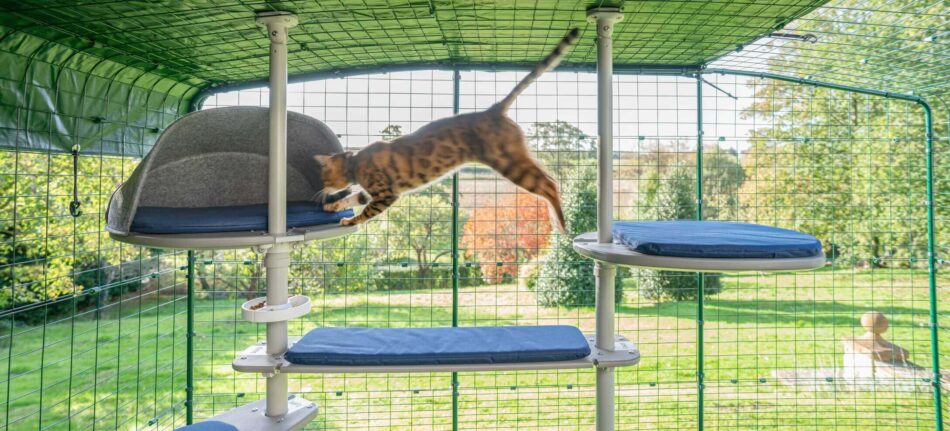
This entry was posted in Cats
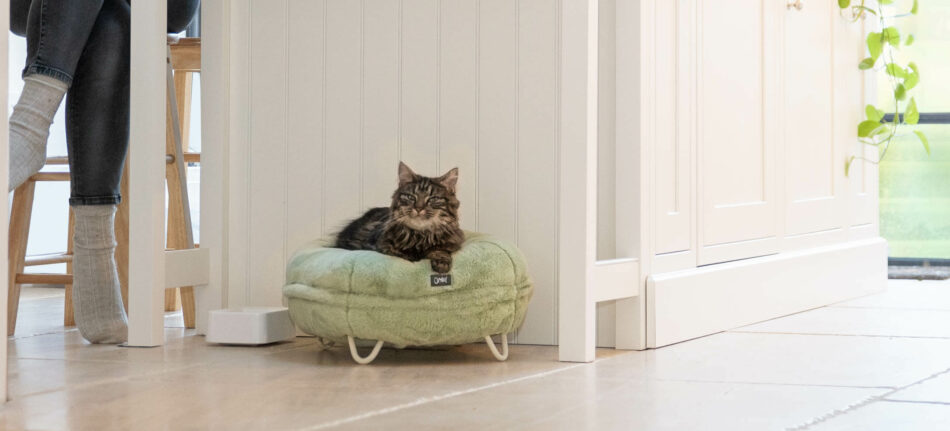
We know all too well how hard it can be to spend time away from your favorite furry friend. So we created an essential cat sitter list to provide you with everything you need to know to make this separation go smoothly. With our help and a little preparation, trusting your cat with a cat sitter can be easy.
Whether for a work trip, a vacation or even just a weekend away, there will inevitably come a time when you will have to leave your cat home alone. So how can you be sure they’ll still be taken great care of? Enter a cat sitter.
Do I need a cat sitter?
Cats have a pretty strong reputation as solitary pets. And while it’s true they like to spend copious amounts of alone time, that doesn’t mean they should be left to their own devices for too long. In general, most vets agree that cats can be left alone for up to 24 hours so long as they have access to fresh water, food and a litter box. And don’t forget a comfortable place to sleep like the Maya Donut Cat Bed!
So how do you know if you need to solicit the help of a cat sitter? If you have travel plans that will keep you away for longer than a day, it’s time to schedule some cat care help. And as a responsible pet parent, identifying a reliable cat sitter is an important part of owning a cat.
How to choose a cat sitter
Choosing the right cat sitter for your kitty is not an impossible task. In fact, sometimes the best cat sitters are friends, family or neighbors that your cat knows well and feels comfortable around. But before you hire a familiar face or a professional sitter to take care of your cat, here are some questions you should be sure to ask:
- What services do they offer? Depending on how long your travels will take you away from home, you need to decide exactly what you want your cat sitter to do. Ask ahead of time if the sitter offers more than just a once-a-day stop to refresh water and food. Some cat sitters may be able to change out litter boxes or even have an outdoor play session with kitty if you have an outdoor cat enclosure.
- What experience do they have? While your cat sitter doesn’t have to be a professional of over 20 years (although that would be great!), it is important that they’re knowledgeable about cat care. Most reputable cat sitters will be happy to tell you about their experience and everything they offer.
- What should they do in an emergency? The best protocol for any animal emergency is a well-understood plan. No matter who you choose as your cat sitter, you need to provide contact information for your veterinarian. And then communicate with your cat care provider what they should do in the event of an emergency so everyone is on the same page.
Getting ready for your cat sitter
If you have human children, you know all too well how important lists are when leaving them in the care of a babysitter or family member. Making sure the essentials are met and routines are carried out, as usual, allows everyone to feel more at ease. Well, the same goes for your cat when leaving them with a cat sitter. Here are some examples of information you should include on your list when preparing to leave your cat with a cat sitter.
- Your emergency contact details. Make sure you include any time zone changes in your travel and multiple points of contact, if possible. You don’t want to miss out on a fun FaceTime with your furry friend while you’re away!
- Your veterinarian’s contact information. Be sure to go over a plan of action on when the cat sitter should call you or the vet first.
- Details on your cat’s microchip if applicable. If your cat doesn’t have a microchip but enjoys outside play in a safely enclosed area, be sure you at least have a collar on them that includes your contact information.
- Feeding instructions. Include where the food is kept, how much your cat should eat, and what time each day they should be fed. Overcommunication is always key to avoiding overfeeding!
- Daily routine. For example, maybe your cat likes to play with cat toys after breakfast and then curl into their cozy cat bed for a long morning snooze. The more your cat sitter knows about your cat’s routine, the more comfortable your cat will be while you are away.
- Potty particulars. When it comes to cleaning your cat’s litter box, make sure your cat sitter knows your cat’s bathroom etiquette. All-in-one furniture-style litter boxes like the Maya Cat Litter Box designed by Omlet are great options for your cat and cat sitters alike. Easy to clean and refill with new kitty litter, this litter box is an essential to have in your home all the time, not just when you’re away.
Omlet and your cat
Making sure your cat is comfortable is central to all of our designs – especially when you have to be away from your feline friend. Ensuring you create a stress-free environment for your cat starts with products that make them feel warm and comfortable. So before you hire a cat sitter for your next trip away from home, be sure your cat has a snuggly warm cat bed, plenty of snooze-worthy cat blankets, and several playful cat toys, such as cat scratching posts, to engage those senses. With these Omlet products and your cat sitter essentials, both you and your cat will stay happy when you have to be away from home.
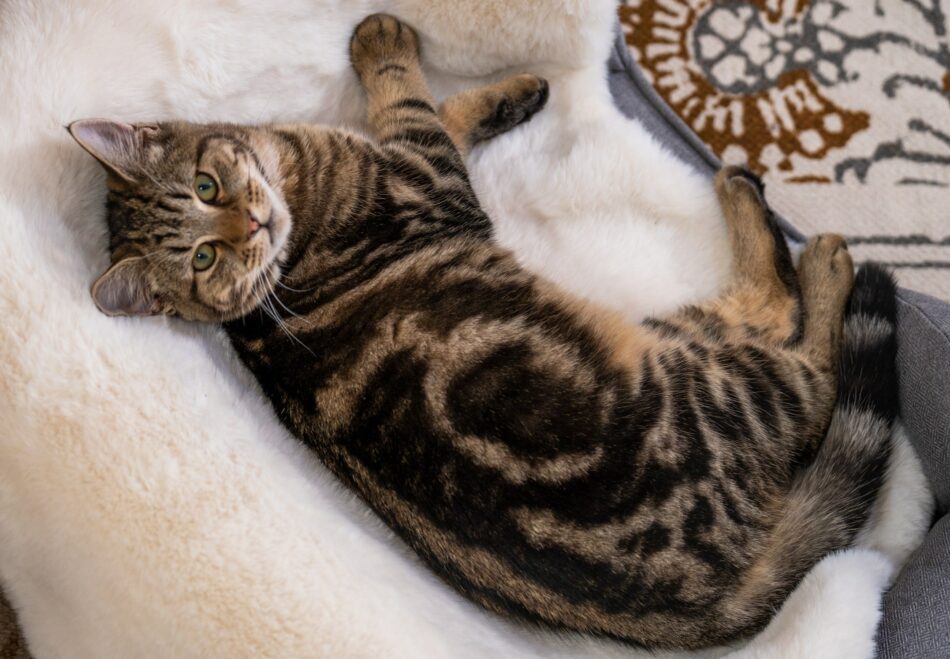
This entry was posted in Cats
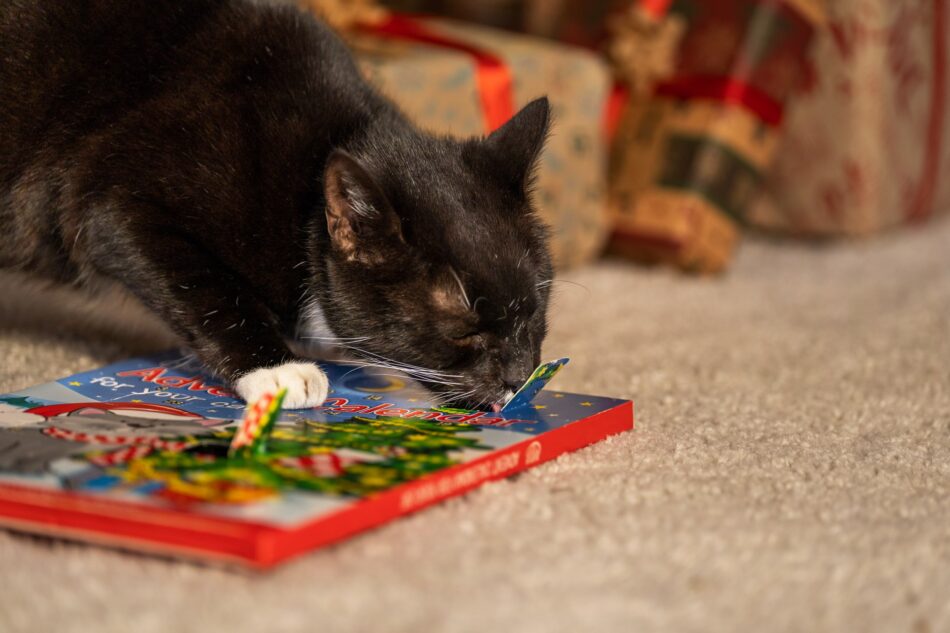
Christmas is right around the corner and so is the enjoyment of time with family and furry friends alike! Since the holidays and food go hand in hand, it would only seem fitting that sharing some extra sweet morsels with your favorite feline would be festive and fun!
But do cats like ham or hot rolls? Can you give your furry friend a sweet taste of the Christmas pies? Before you go giving your kitty any Christmas nibbles, make sure you know which foods are safe to share and which foods could pose a big danger to them. We’ve compiled a list of the do’s and don’ts so you can be sure your cat stays safe this Christmas.
What should a cat’s diet consist of?
In order to know what not to feed your feline, you first need to know what your cat can eat! Cats are obligate carnivores, meaning their diet is made up primarily of animal protein with some plant matter too. They rely on the nutrients available in meats to get the vitamins and fats their bodies need to live a long and healthy life.
As a cat owner, you know just how picky your feline can be! So making sure they get a high-protein and well-balanced diet is essential. The food your cat should be dining on in their cat bowl should be roughly 50% protein, 35% fats, and 15% carbohydrates. What kitty could resist that kind of kibble?
Should cats eat more around the holidays?
It goes without saying that Christmas is the time of year when indulging in delicious treats is not necessarily frowned upon! But is feeding your cat some festive treats ok to do, too? The short answer is yes, but in very limited bits and only with safe foods.
When the temperatures start to drop outside, cats naturally use more energy to try and maintain their core body temperature. But for indoor cats who experience a regulated home temperature, this instinct to increase their appetite need not apply like it does for outdoor cats! Your indoor kitty may seem to be more hungry because their body is instinctively responding to the change in weather. But the truth is, their diet doesn’t need to change unless their environment does.
So what does this mean for your furry friend who is giving clear signals around the Christmas tree that hunger is in the air? By knowing how the change in seasons affects your cat and by being keenly aware of their specific food behaviors, you can adjust your small treats accordingly this Christmas season. Just remember to keep the treats small, simple, and safe!
Not safe foods for cats
With the aroma of holiday treats wafting through the kitchen, your cat is sure to be on the hunt for some extra bits to nibble on this Christmas. But as we’ve uncovered, not all foods are safe for your kitty to eat and, in fact, some can be extremely harmful to them if ingested. So in order to keep your cat safe, here are some foods to avoid letting them eat at all.
- SPICES: Garlic and spice make everything nice, right? Not for cats, they don’t! Some of the most harmful ingredients for cats to eat are actually spices that are found in many holiday dishes. Garlic, onion, chives, or any other spice that is a member of the allium family are very dangerous for cats to eat. These tasty additives have compounds that can cause cats to have severe vomiting and diarrhea. So when giving your cat a nibble of Christmas meat, make sure it is unseasoned!
- CHOCOLATE: When the holiday season is in full swing, the coziness of warm fires and hot chocolate are felt all around! But for your cat, chocolate is anything but a cozy treat. The sugary sweet treats of chocolate are harmful to cats as they contain caffeine and theobromine, both of which are toxic to cats and can cause kidney failure.
So in order to keep your cat safe this Christmas, keep the advent calendars, candy bowls, and any sugary treats out of reach and away from curious and climbing kitties!
- DAIRY PRODUCTS: Santa’s milk is ok for your kitty to sip, right? Not so much! Most people don’t realize it, but the majority of cats are actually lactose intolerant. Yes, it’s true that almost any cat will happily lick up the frothy white yumminess of milk if given the chance, but this “little treat” can actually cause stomach cramps for your furry friend. So best to stick to water when treating your cat to a drink this Christmas!
Safe foods for cats
While there are certainly limitations on what morsels you can treat your cat to this holiday, all is not lost! Keeping your cat’s diet consistent and well-balanced throughout the year is important, but if you want to feed them small bits of festive food this holiday, here is a list of some safe options!
- PLAIN TURKEY: Your cat can certainly have a nibble of the star of the Christmas table! When dishing out their small portion, just be sure it is unseasoned, fully cooked, and has absolutely no bones in it. No one wants an emergency vet visit on Christmas.
- PLAIN SALMON: What goes better with a cat on Christmas than a slice of salmon? If your holiday celebration includes the dish of seven fishes, then including your cat is ok! Salmon is a perfect fish choice to share sparingly with your cat as it is loaded with protein and omega fatty 3 acids that are super beneficial for their brains and bodies. Just be sure to give in moderation as once a cat tastes the goodness of plain, fully cooked salmon, they may not want to eat anything else!
- RAW VEGGIES: It’s true that cats are predominantly carnivores, but over time and through domestication, their diet has adapted to include small amounts of vegetables as well. When it comes to giving any pet carrots, brussel sprouts, pumpkin, or broccoli, you must make sure they are uncooked and unseasoned so as not to hurt their digestion.
An Omlet cat Christmas
At Omlet, we believe cats are part of the family, so pets should enjoy the holidays, too! But for some cats, having a safe Christmas means retreating to a space all their own so they can avoid any harmful foods altogether.
That’s why we created the Maya Indoor Cat House as a great option for any cat who seeks a secluded sanctuary that is cozy and cuddly. Christmas is all about giving! So give a small bite or two of the safe foods to your cat this Christmas and then let them do what they do best – relax in a cat nap! Meowy Christmas!
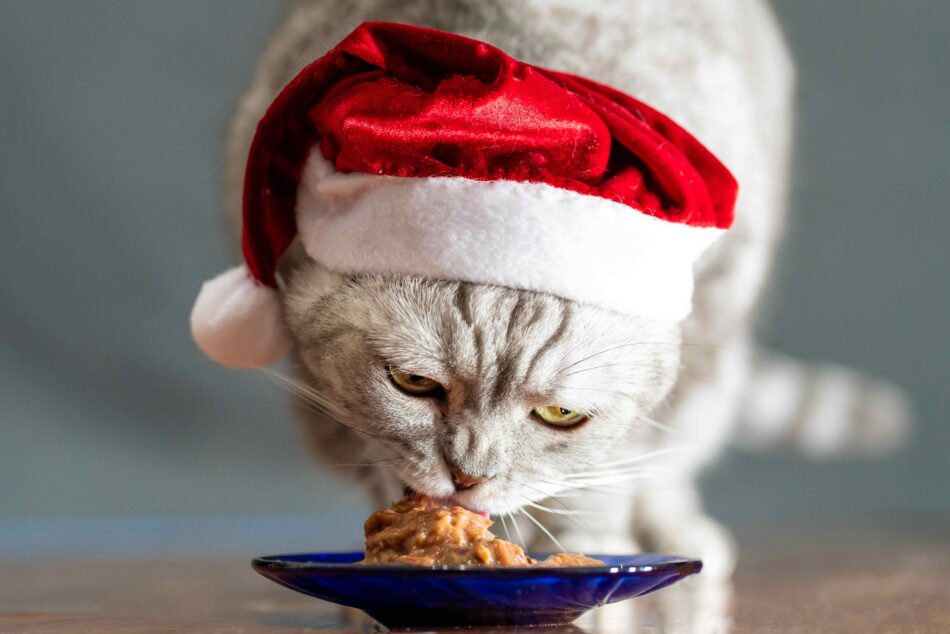
This entry was posted in Cats
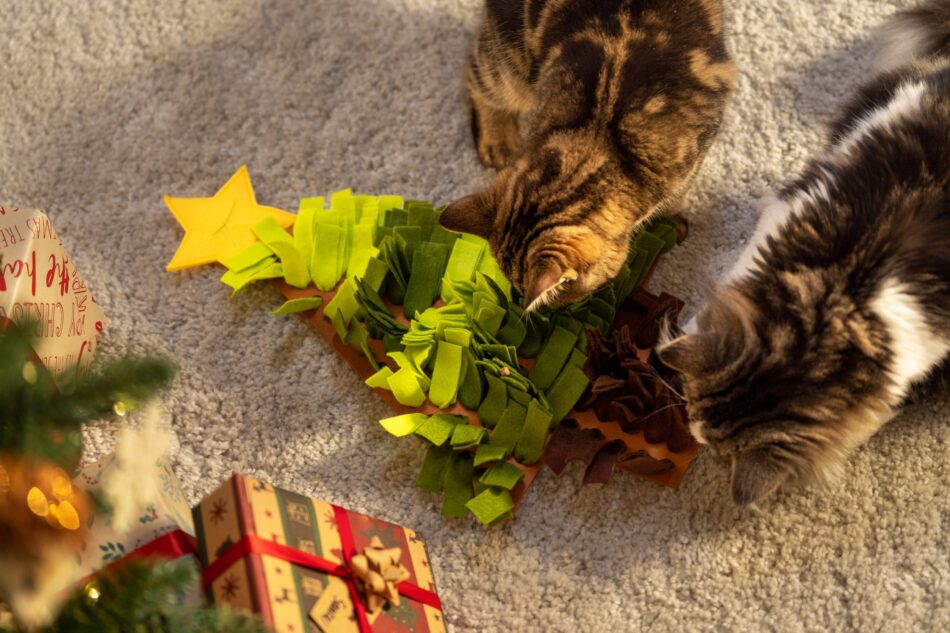
‘Tis the season for turkey, stuffing, and everyone’s favorite—crispy roast potatoes. Christmas is a time for gathering with your family and friends and savoring all the deliciousness the holiday brings.
While it’s important to soak up the wonder of this magical season, don’t forget to make sure your cat enjoys this special time of year too. Keeping your kitty safe this Christmas means knowing the “do’s and don’ts” of holiday cat safety, and we’ve got your guide to everything you need to know.
Safe Christmas foods for your cat
With the scents of mulled wine filling your kitchen and the aroma of rosemary drifting from the oven, it’s hard not to want to share the delicacies of Christmas with your favorite feline. No more than 10% of your cat’s diet should come from treats, and that’s especially true during the holidays.
We know you want to include your feline friends in the festivities, so here are some foods that are safe to feed your cat—in limited amounts—this Christmas:
- Turkey: The big question every pet owner wants answered is, “Can my cat have some turkey too?” The answer is yes! Just make sure the bites they get are unseasoned, fully cooked, and boneless. Certain spices, like garlic and onion, can make a cat sick, so be sure your cat’s turkey portion is plain but tasty.
- Apples: If apple pie is on your Christmas menu this year, your cat is in for a treat. Apples provide a nutrient-rich source of vitamins that are healthy for your furry friend. Before assembling the pie, cut up an apple slice into small pieces for your kitty to nibble on—it’ll be just like dessert for them.
- Potatoes: Whether you boil, bake, or mash them, potatoes are a Christmas staple on every holiday table. And good news for your cat—they can enjoy them too. Just be sure to offer only fully cooked and plain potatoes. Raw potatoes can be toxic to cats, and butter can upset their stomach, so stick to the unseasoned, cooked variety and your cat will dine happily.
Christmas foods to avoid
While sharing is caring, there are some risks when it comes to giving certain Christmas treats to your cat. A cat’s digestive system is very different from ours, so foods we eat regularly could have serious side effects on your cat’s health.
Here’s a list of Christmas foods to avoid giving your cat this holiday season:
- Chocolate: With friends and family visiting, there are bound to be tins of chocolate on the tables for sweet treats. But remember—your cat is curious and likes to climb, so any bowl left out (and unattended) is a sure temptation. Chocolate is extremely toxic to cats and can make them very ill if eaten, so keep the candies and wrappers out of reach this Christmas or send them home with guests to make sure your kitty stays safe.
- Alcohol: It should go without saying that alcohol is not a cat-approved menu item, but during the hustle and bustle of Christmas, it’s a good idea to know where all the wine glasses are set throughout your house. Curious kitties love to explore, and half-finished wine glasses left on tables by guests can be dangerous for your feline friend. Even just a few sips of alcohol can cause vomiting and diarrhea for your cat, so make sure your guests keep their drinks with them at all times.
- Raisins: Fruitcake and oatmeal raisin cookies might be some of your favorite holiday treats, but raisins are extremely dangerous for cats. Be mindful when planning your menu this holiday season, since this fruit can cause irreversible and sometimes fatal kidney failure if eaten by your kitty.
If your cat does get a hold of any of these “no-no” foods, call your veterinarian right away for help.
Feline-friendly festive décor
Along with delicious foods, the Christmas spirit comes alive with decorations throughout your home for that cozy, winter wonderland feel. But as a cat owner, it’s important to know which festive décor items could be potentially harmful for your feline friend.
Adding festive plants around the house to boost the holiday spirit can, unfortunately, be dangerous for your cat. While there are many plants that are safe and non-toxic for your cat, traditional holiday plants like poinsettias, holly, and mistletoe are extremely toxic to cats. If you’re set on having those red and green holiday vibes, consider using artificial plants that bring the same festive cheer but are safe for your cat.
Another popular décor item during the holidays is beautifully scented candles. The flicker of the flames and the scent of warm vanilla can make your home feel extra cozy in winter. But open flames, whether candles or fireplaces, can be a big danger for your cat during the holidays. A curious cat can quickly get burned, or worse, knock over a burning candle and start a fire. Instead, try flameless candles for a festive glow and keep a gate in front of the fireplace.
Finally, as you add lights around the house and on the Christmas tree, remember to keep those electrical cords covered. You can’t stop your cat from being curious, but you can stop them from getting hurt. Exposed electrical cords are like an open invitation for cats to chew, and you don’t have to be a cat owner to know that’s not a good thing. So as you deck the halls with sparkling lights, make sure you tape down and cover the cords so your curious kitty can stay safe and enjoy the view too.
Cats and Christmas guests
As you welcome friends and family into your home to celebrate Christmas, remember that it’s your cat’s home too. While your cat may not pay the mortgage or bills, they definitely feel a sense of ownership over where you live.
So what do you do if your cat doesn’t like houseguests? With all the commotion that comes with hosting people at Christmas, be mindful of your cat’s personality to make sure their needs are met for a peaceful holiday season. Some cats love company while others are shy, so before you tidy up the guest bedroom, here are some tips and Omlet products to consider:
- Create a kitty cave: If your cat is shy around strangers, it’s super important this holiday season to make sure they have a place to escape. Dedicate a room in the house where your cat can retreat to avoid any stress. You can even add a climbing tree, like the Freestyle Indoor Cat Tree designed by Omlet, so your cat can have some festive fun of their own.
- Tire them out ahead of time: The best way for your cat to avoid holiday stress is to sleep right through it. Before your guests arrive, make sure you get in some quality playtime with your furry friend so they’ll be ready to nap. The Switch Light Up Cat Scratcher from Omlet is a great way to tire them out before the party starts.
- Cozy quarters to the rescue: While some cats like to hide when new people come over, many are open to meeting new faces and making new friends. But all cats like to have their own space when they need it. So for the kitty that likes to mingle—but not for too long—make sure they have a cozy spot to retreat to when they need a break. The Maya Donut Cat Bed from Omlet will keep your kitty comfortable and cozy, and it looks great in any home.
Keep the stress and demands of holiday prep at bay by using these tips and products to make your cat’s Christmas one to remember. Without a doubt, you’re at the top of their Christmas wish list too.
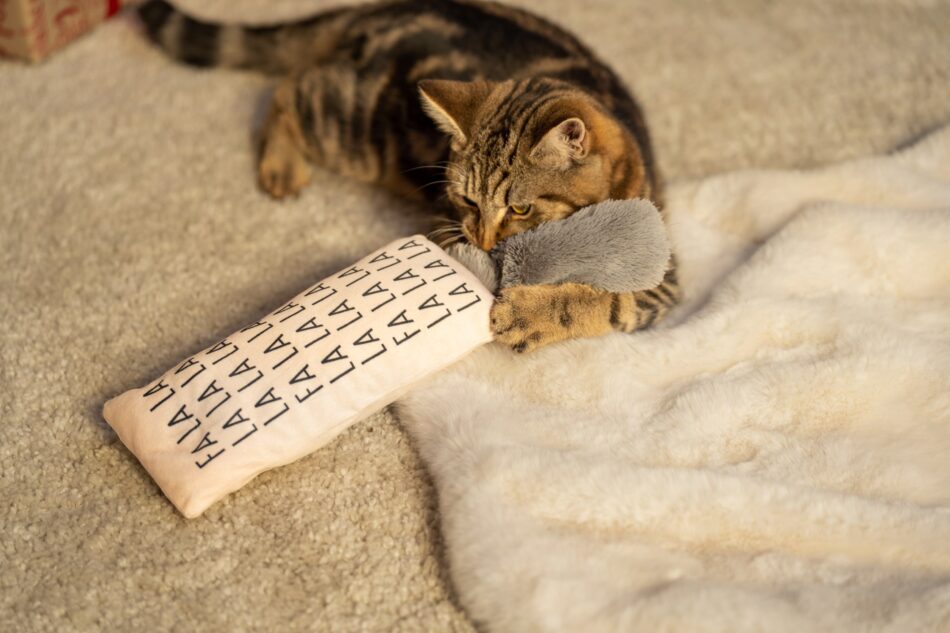
This entry was posted in Cats
Cats and cold weather don’t always mix. Some cats relish exploring in the snow and ice, while others prefer to relax in the comfort of the great indoors. No matter where your cat’s interests lie, learn about the biological changes they’re experiencing this time of year, and find out how to support them throughout the winter season.
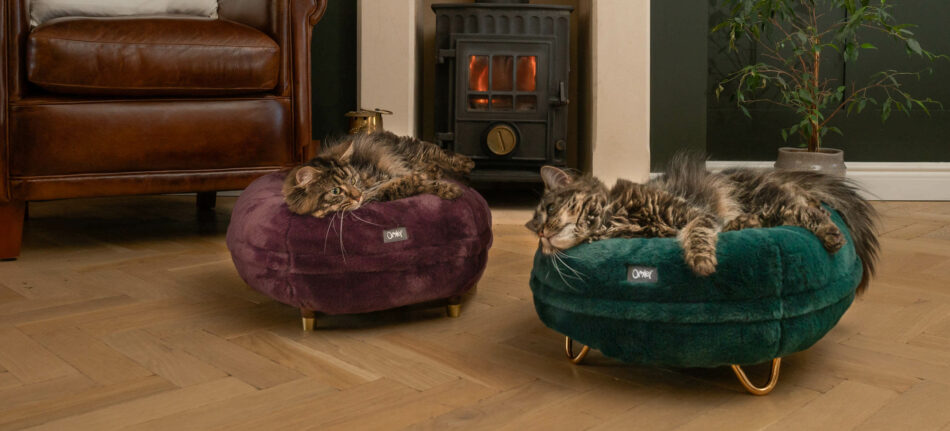
Does the cold affect cats?
Like all animals, cats are in tune with seasonal changes— and winter is no exception. Even cats that spend all of their time indoors aren’t exempt from biological shifts throughout the year. Here are some common changes you’ll notice from your feline during the winter months.
Changes in your cat’s coat
As the number of daylight hours dwindles toward the end of fall, your cat will have shed their undercoat to regrow a more dense coat for the winter. This natural process is triggered by the shorter days, and occurs in all cats — both indoor and outdoor. Some owners even notice their cat’s winter coat taking on a slightly different color or texture than during the rest of the year.
Your cat will be busy keeping up with their new winter attire, and you can aid them in their endeavor by brushing them daily. More hair can also mean more hairballs, so monitor your cat’s digestion closely. Avoid brushes that strip them of their undercoat and don’t dress your cat in pet clothing, as both of these can damage the protective undercoat they’ve worked so hard to grow.
Colder weather is for catnapping
Cats are professional nappers all year round, but you may notice an uptick in their snoozing schedule during the winter. With the world outside falling mostly dormant and their window-watching opportunities limited, most cats opt for extra slumber during the day. This is especially true if you keep your home on the cooler side, which will give your cat extra encouragement to find a warm place to curl up for a catnap. Keep a comfy cat bed in a warm location like under a window with afternoon sun, or near your fireplace to help your cat catch some quality sleep.
But all of this sleeping comes with the risk of your cat gaining weight over the winter. Weigh your cat regularly to make sure they aren’t packing on seasonal pounds, and avoid offering extra treats. Furnish your home with an indoor cat tree to encourage more movement during their waking hours, and offer a cat scratching post to stretch their muscles. Both of these encourage and support natural behaviors that will keep your cat’s mind and body engaged and active.
Do cats get too cold?
While it’s very unlikely that indoor cats will get too cold, this is a very real possibility for cats that spend time outdoors. When temperatures or wind chill create conditions below freezing, cats can experience hypothermia, or low body temperature. Signs of hypothermia in cats include:
- Lethargy
- Shivering
- Slow heart rate and breathing
- Dilated pupils
- Pale mucous membranes
- Uncoordinated movements
To avoid hypothermia in your cat, keep them inside when temperatures fall below freezing. If your cat insists on going outside, consider attaching a catio to an exterior door or window. This will give your cat access to the outside world while keeping them close to home. Offer cat run accessories like an outdoor cat tree and cat run covers to give them ample space to escape the elements.
Dangers for cats in the winter
In addition to a too-low body temperature, there are other concerns that winter can bring for cats in particular. The most notable areas for caution are:
- Antifreeze and de-icing chemicals. These are sweet-smelling and pique a cat’s curiosity, but they’re highly toxic. Don’t let your cat roam during the winter months, and clean their feet promptly if they walk across any surfaces that have been treated for ice.
- Cats hiding in engine blocks. A car that has recently been parked and turned off will radiate warmth — which will entice cats that are out in the cold. A cold cat will crawl up into the engine block from underneath a vehicle, which puts it in a very dangerous position when the engine starts. Always check under the hood of your car before starting it in the winter, particularly if your cat frequents where you park.
- Opportunistic predators. Predators are also feeling the effects of winter, and their hunger can turn their attention to your cat. Keep your cat inside during dawn and dusk, which are peak predator hours, and keep them close to home in a cat run to prevent wandering.
Omlet and your cats
We want you to be able to keep your cat safely supported and entertained throughout the winter. That’s why we invented products like the Catio, Switch Cat Scratcher, and the Indoor Cat Tree to channel their inner nature in a safe environment. Keep your cats occupied during the cold months, and the rest of the year, with cat products designed to bring you and your cats closer than ever.
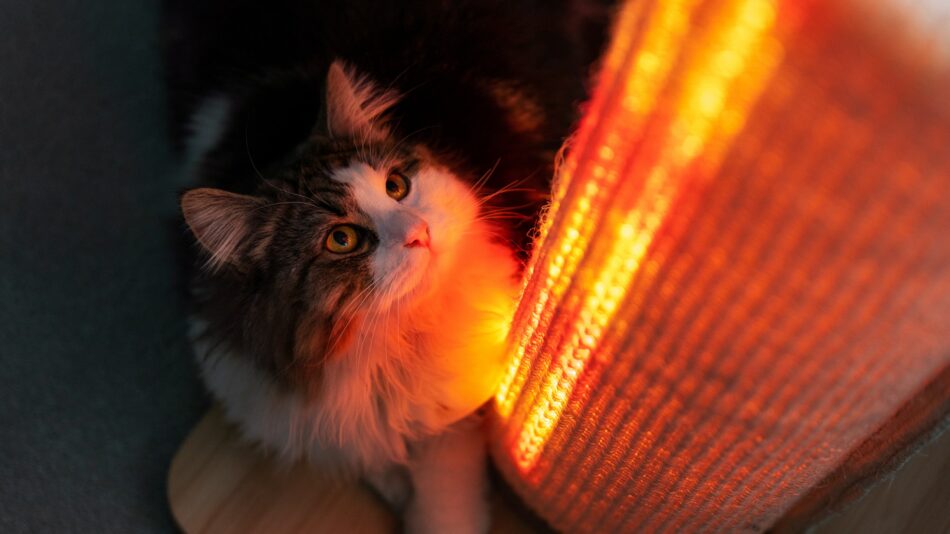

This entry was posted in Cats
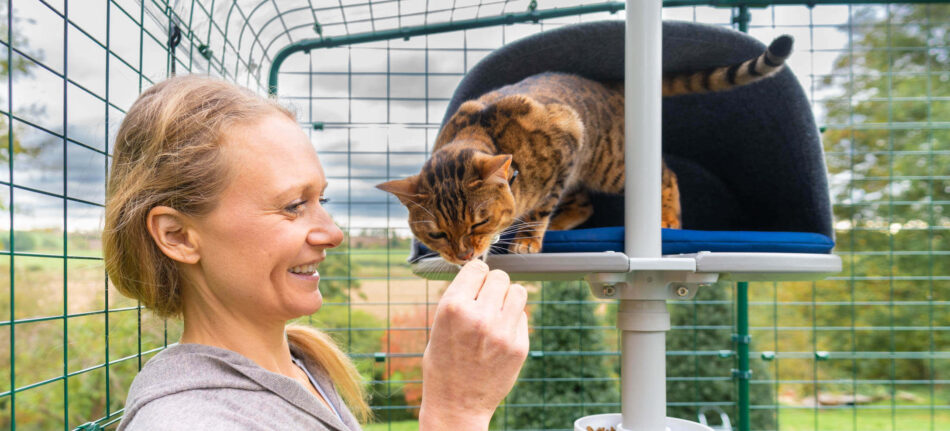
If cats had their own outdoor play space what would it be called? A kitty keeper? Cat crib? Or maybe a meow house?
For decades, one word has been used to describe an outdoor enclosure for cats: “catio”. But what is a catio? A blend of the words cat and patio, a catio is any safe outdoor enclosure for cats. At Omlet, we didn’t invent catios, but we did purrrfect them!
Why are catios so great?
If you are a cat owner then you know first hand that your feline friend appreciates fresh air! Whether it is through an open window or closed screen door, most cats will instinctively move towards the scent and relaxation of outdoor air whenever possible. It makes sense, right? Cats are native to the wild and having the ability to roam and move in an outdoor space feels, well, normal!
So let’s take a closer look at all the reasons why outdoor catios are so great!
- Spacious Outdoor Freedom: With the Catio designed by Omlet, any cat can play safely and freely in the fresh air. The modular design of the outdoor cat enclosure means you can create a catio that suits your specific backyard space and pets! Just check out our easy-to-use Catio Configurator to start creating your own perfect catio!
- Totally Customizable: We not only made the size of the catio completely customizable, but we ensured the overall design was as well! Looking for a way to add additional security to your catio? How about a porch! The Catio Porch designed by Omlet was created with both security and space in mind. The two-way door system allows you to enter the catio at any time without worry of your feline friend trying to join you as you leave!
- Assembly And Look: One quick search on the internet will provide you with dozens of different DIY or custom catio options. Our product engineers had specific objectives in mind when creating the Omlet Catio: an easy to assemble product that was sturdy and unobtrusive. Made from a strong steel mesh that is painted in a natural blending green, the Omlet Catio will not only keep your cats safe, but keep your backyard looking good while doing it, too.
Why should you get a catio?
So you’re looking to add a catio to your outdoor space? Congratulations! The ability to move outdoors is incredibly beneficial for cats. But catios offer so many more benefits to your feline friend.
Safety: By nature, cats are very curious creatures and they love to explore their surroundings by climbing new heights. However, this may sometimes become a danger when done indoors. The greatest benefit of the Outdoor Cat Run Enclosure is the ability for your cat to climb, jump, and run as much as they like without worry of hurting themselves or others. The Catio not only keeps them safe from indoor dangers (like falling bookshelves!), but from outdoor dangers, too (like wild predators!).
Fresh Air: Think about the last time you stepped outside in fresh air and took a deep breath. We know how relaxed you felt! Cats feel the same way! When outdoors, cats receive the same benefits of fresh air that we do – increased circulation, improved mood, and overall better health! What greater gift could you give your cat than a longer, healthier, and happier life?
Happy Neighbors: Being “neighborly” is always the right thing to do! However, letting your cats roam around outside without an enclosure could potentially lead to a case of kitty trespassing. And that’s not very neighborly! Catios are the best of both worlds because they provide the great benefits of being outdoors but within a secure space so your cat can’t end up in someone else’s yard. And your other backyard wildlife, such as birds and chipmunks, will thank you, too! While in a catio, your feline friend is no longer a natural predator to these smaller prey.
How to choose the right catio
If you are a handy human who has great workmanship skills, then building a DIY catio might be the best option for you. But for the rest of us, assembling and installing a custom ready-made Catio is the easiest option!
Backyard catio
The backyard is the most obvious place to put a catio. But you don’t need a huge backyard to create an outdoor cat oasis. In fact, just a small area will work as our Outdoor Run Enclosure can be designed as small or as large as you like!
Here are the simple steps to get started building your own catio:
- Decide where in your backyard you want to place the catio. You can have it freestanding or up against the house for easier indoor/outdoor access.
- Measure the space.
- Choose what size catio you want! You can either pick a pre-configured option ranging from 6’x6’ up to 9’x12’, or customize the length, width or height to your specific needs.
- Order your Catio by Omlet and get ready to give your cat an incredible experience!
Apartment/balcony catio
Is it possible to still have a catio when you live in an apartment or condo? Absolutely! The Cat Balcony Enclosure by Omlet was designed specifically with these dwellers in mind. We made the Balcony Catio narrow enough to fit any size balcony and offer an extendable length option from 6ft-12ft so you can install with ease! This enclosure is a simple solution that allows you to rest assured that your cat will be completely secure in this escape proof design.
How can you customize your catio?
When it comes to adding accessories to your catio, the options are endless! Our product engineers know cats and they created these feline friendly products with your purrfect pal in mind!
Cat tree: Omlet’s Freestyle Outdoor Cat Tree is the number one must-have item to include in your catio! This easy to install pole design is any cat climber’s dream and was created to be the last outdoor cat tree you will ever need! Choose from a wide variety of attachments to add to your Freestyle, such as a hammock, scratching post, or ladder. Your cat will want to spend hours relaxing and being entertained in their catio!
Partitions: What if your catio had multiple rooms? Another great way to customize your catio is by adding partitions. If you have more than one cat, or are looking to add a new feline to the family, this is a great option to allow all paws outdoor play without getting too close.
Weather covers: Rain or shine, your feline will be just fine with Run Covers from Omlet. We know cats don’t like to get wet and too much heat on a sunny day is not favorable! So adding weather covers to your catio will keep your cat happy while they still get to enjoy their outdoor space.
So now that you know what a catio is, you are fully equipped with all you need to create an outdoor cat kingdom! And even though your cat may still think every room on the inside of your home belongs to them, they will love their catio for the dedicated space that is completely their own!
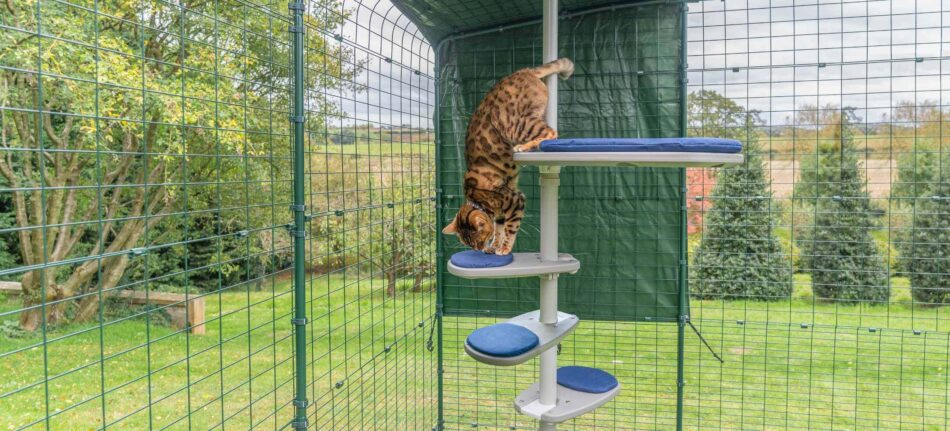
This entry was posted in Cats
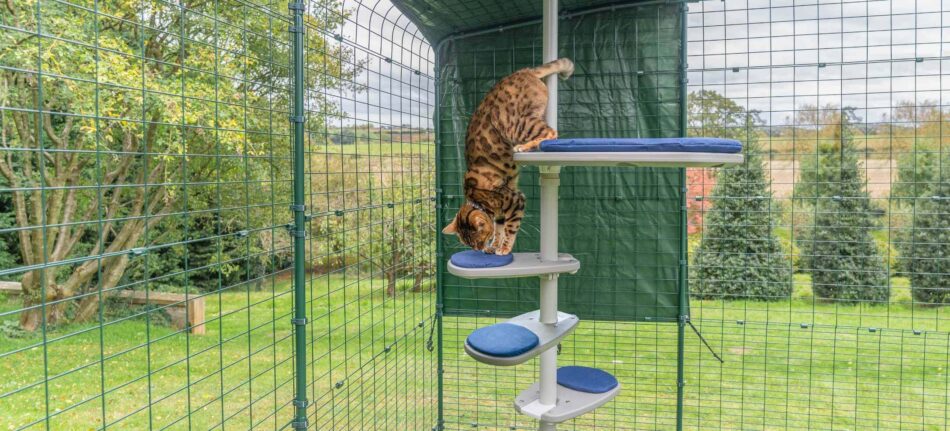
Catios have become increasingly popular among feline owners! These enclosed outdoor spaces are the perfect way to let your cat enjoy the benefits of fresh air but with the safety and protection from outside dangers or predators.
Whether you have a small apartment in the city or a large backyard in the country, you can create a catio of any size to suit your furry feline friend! And we have all the outdoor catio ideas you need to get started!
So, what exactly is a catio?
The word “catio” came from the idea of a patio for cats (cat + patio = catio). In basic terms, a catio is a safely enclosed outdoor space where cats can enjoy the sunshine and fresh air without you worrying about them getting hurt. But why are they important for cats?
- Protection of your cat: Cats are curious by nature. The number one reason cat owners have a catio is to let their cats be outside safely, allowing their curiosity to shine!
- Protection of wildlife: A catio protects other wildlife, like birds and chipmunks, from your cat! Remember that cats are predators themselves by nature, so when given the chance to roam outside, their instincts will kick in! So be sure to have an enclosed space for them to enjoy!
- Healthy lifestyle: There’s no denying that everyone feels better when outside and in sunshine! Cats feel the same way, too! And when they are exposed to fresh air and movement on a regular basis, they live a longer and healthier life as a result.
- Reduction of indoor smells: Is your indoor litter box starting to smell too much? A great benefit of outdoor catios is that they provide another spot for your litter box. This way, the smells can stay outside!
- Keeps neighbors happy: Stop kitty trespassing! The catio is the perfect solution to let your cat enjoy the outdoors without roaming into your neighbor’s yard!
Catio ideas for backyards
You don’t need a huge backyard to create a wonderful catio space – even just a small area will do! Outdoor catios can be as small or as big as you like and can even be customized to provide one-on-one outdoor bonding time with your cat! Let’s take a look at all the catio ideas for backyard spaces:
Freestanding catio: At Omlet, we didn’t create the Catio, we purrfected it! With our customizable cat run we designed a safely enclosed outdoor space that both you and your cat can enjoy! Place a cat tree inside for your cat to climb and a bench swing for you to sit and enjoy watching! Outdoor bonding with your cat has never felt so good! This sturdy and spacious enclosure has been rigorously tested and is the safest and most easy to use catio on the market!
Catio attached to house: What if you are stuck working inside when your cat wants to go outside to play? Don’t you want to enjoy that fresh air, too? Well, you can! There are several DIY solutions to attach the Omlet Catio to your home, allowing you to leave a space open so your cat can move freely between the inside and outside. Some options include building a mesh tunnel from a window into the catio or just simply move the Omlet Catio up against the house so your door opens directly into the enclosure. The options are endless when creating backyard catio ideas!
Catio ideas for apartment balcony
Don’t let where you live dictate where your cat can go! The Cat Balcony Enclosure designed by Omlet provides a simple, yet elegant solution to outdoor cat living. This fully secure and escape proof catio fits on almost any size balcony and can be customized to suit your exact needs.
Attach a hammock to a cat tree so your cat can lounge around and add a bean bag chair in the corner so you can take an outdoor cat nap, too! And if you are worried your cat might try and escape when you open the door, just add a porch to have an additional layer of security!
The Cat Balcony gives your cat the freedom to explore the outdoors without the compromise of space!
Catio decorating ideas
Decorating your catio is part of the fun of owning one! Let’s take a look at these feline friendly decorating ideas!
Outdoor cat tree
The Freestyle Outdoor Cat Tree designed by Omlet is a great addition to any outdoor cat enclosure. Completely customizable with all things that cats love, this outdoor cat tree will allow your feline friend to explore so many new heights and sights. From platforms to scratching posts, the options are endless with what you can create!
Partitions
The Catio Outdoor Partition designed by Omlet is made from the same strong steel mesh as the catio enclosure. This secure and lockable door gives you the ability to create sections for multiple cats. Whether you are introducing a new cat to the crew or just wanting to create separate eating spaces, this partition provides the necessary separation with ease!
Weather covers
Cats like to be outdoors, but they hate getting wet! Adding a heavy duty tarp to the top of the catio gives your cat the best of both worlds! The Omlet product designers created this cover to specifically fit the catio and made it incredibly easy to install and maintain. Not only will it keep your cat dry when it rains, but it will also provide much needed shade when the sunny days are too hot!
The added stimulation and benefits that cats receive from being in an outdoor enclosure are numerous. And as a pet owner, you can create a custom outdoor cat paradise with all of these catio ideas!
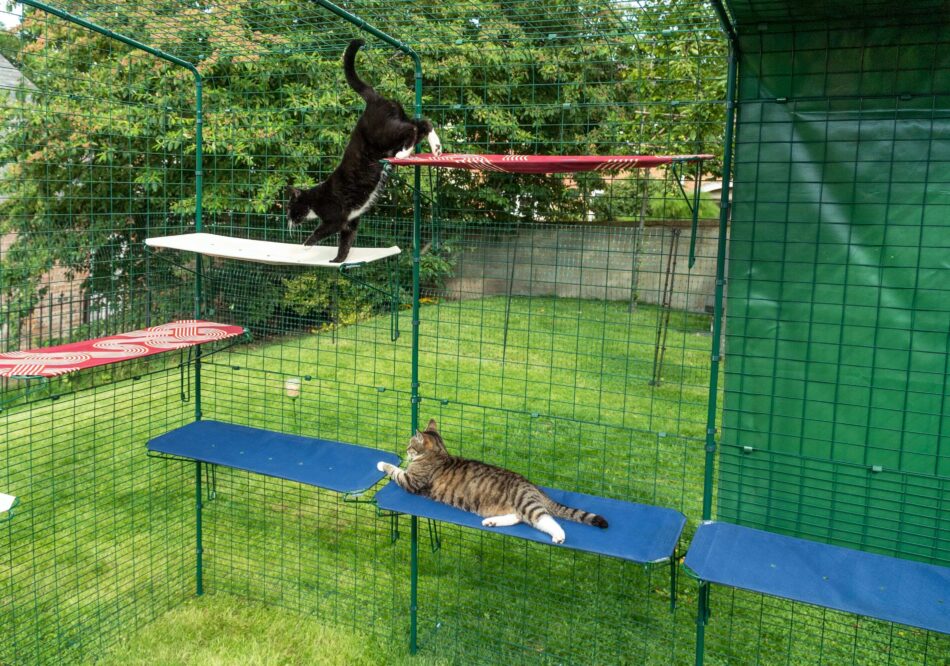
This entry was posted in Cats
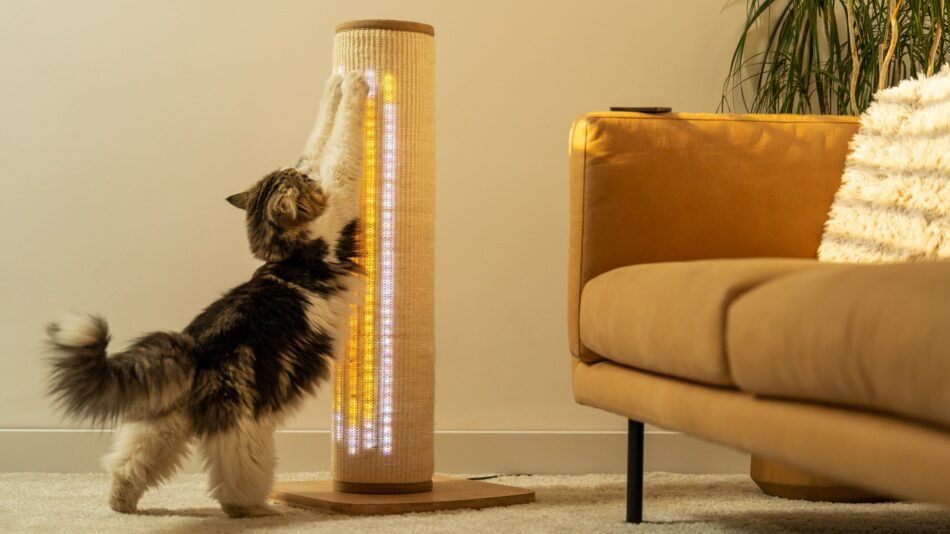
You’ve searched high and low and finally found your new feline friend to be your forever bestie – congratulations. But wait – do you have everything you need to make your new cat feel at home? Have you prepped your house with all the necessary new cat essentials? Don’t fret – we have you covered. Before you go buying too much kitty litter, take a look at this new cat checklist to make sure your feline friend has everything they need before they move in.
Food
It should go without saying that food and water are essentials to have plenty of when bringing home a new cat. But how do you know what food to buy? Cats and kittens need different food as the digestive systems of kittens are still developing and require a more specialized diet.
While there are many brands and options of cat food to choose from, it’s important that you find one that has the ingredient taurine. An amino acid that makes up proteins in plants and animals, taurine is essential in a cat’s diet to aid in heart, retinal, and digestive functions.
Feeding your cat an all-vegetarian diet is a no-no. Cats are one of the truest carnivore animals and they require protein in their diet to keep them healthy. So be sure you read the labels before buying their food.
It’s also important to remember that cats are curious by nature and like to bat objects with their paws…such as food bowls. So be sure to have sturdy pet bowls that won’t tip over and are also easy to clean.
Litter box
Ah, the kitty litter box. If you’ve ever been a cat parent then you know all too well just how essential this item is. We have to remind ourselves that litter boxes are the equivalent to our favorite bathroom in the house. So when it comes to buying the right litter box for your new cat, size matters.
The general rule of thumb is to buy a litter box that’s 1 ½ times the length of your cat. Your feline friend is fickle and doesn’t want to feel cramped when using the toilet. And can you really blame them? Since this is the spot where your cat will do all their “business”, adding some privacy with an enclosed cat litter box is always a good idea.
The Omlet Maya Cat Litter Box is a great option as it offers a range of entry-point options to suit any cat. The sleek enclosed design not only minimizes smells and messes, but doubles as a piece of furniture for your interior design. And speaking of smells, check out these scented cat litters that are not only a healthy choice for your nose, but for your cat and the environment as well.
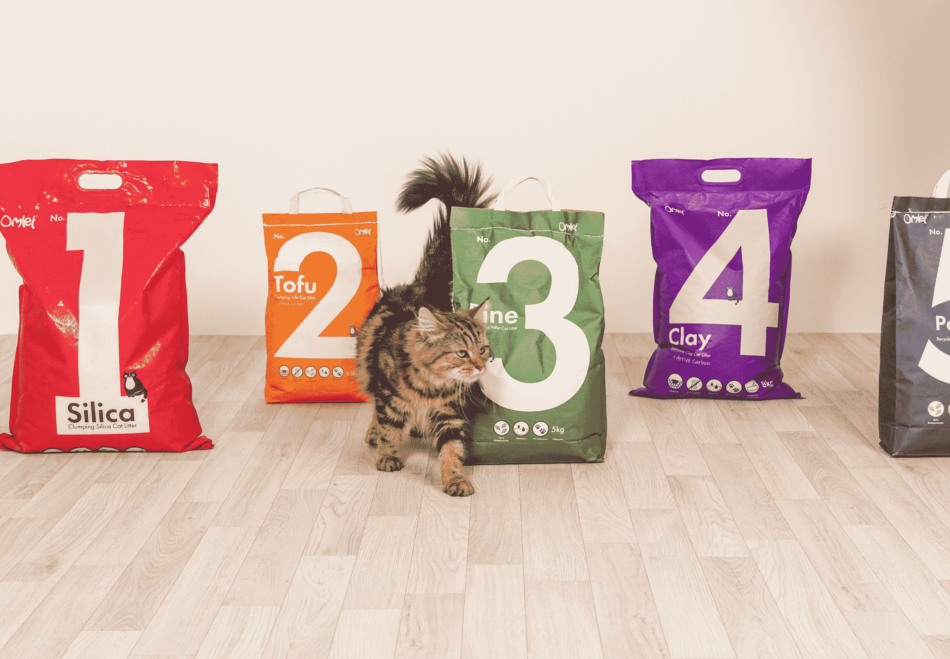
Grooming and hygiene
Believe it or not, one of the best bonding activities for you to do with your cat is to brush them. Yes, that’s right, while cats typically do self-grooming all day long, they actually love the sensation of being groomed. And long-haired cats, like Persians or Maine Coons, need daily attention to their coats to keep them healthy. So be sure you have a good comb or brush to help your cat stay tangle-free.
When it comes to baths and nail trimming, sometimes this is best left to the professionals like your veterinarian or a professional groomer. It’s important to keep these essential hygiene needs as positive experiences, so if you feel you are unable to handle a cat in the water, then seek advice from your vet for options.
Cat toys
There really is no better way to form a long-lasting bond with your cat than through play. Cats are predatory by nature and have instinctual needs to release bursts of energy. Playing also helps your cat to relieve any boredom that could lead to too much curiosity. And what better way to give your cat some good exercise than through a fun play session.
At Omlet, our mission is to rethink every aspect of caring for your cat. So we engineered a revolutionary product that meets your cat’s every need with technology that brings you both closer together. Meet the Switch Sisal Cat Scratching Post, designed by Omlet – a one-of-its-kind cat scratching post that has integrated LED lights to bust your cat’s boredom and connect you with them in color. Engage all of your cat’s senses with the cat scratching post that will provide endless hours of fun and function.
Also, be sure you have plenty of cat toys on hand before bringing your new cat home and then take some time each day to engage with your cat. The mental and physical stimulation they will receive in just 10 minutes of play each day will be beneficial for their lifetime.
Cat bed
Cats like to sleep…a lot. So one of your new cat’s key essentials is a bed. But not just any bed will do. In the wild, cats often sleep in elevated places to avoid predators or in homemade dens to feel comforted and secluded. So when buying the right bed for your cat, be sure you find one that suits their specific needs.
The Omlet Maya Donut Elevated Cat Bed is a perfect option as it addresses your cat’s specific needs for support and comfort. This cozy, ultra-soft cat bed delivers a first-class sleeping experience to any cat. With a slight elevation and nested cushioning, your cat will find this bed to be the best cat nap spot in the house. And bonus – the cover is machine washable so you can keep your cat and their sleeping quarters clean.

Cat tree
If you want to keep your furniture free from scratches, then you’ll need to invest in a good cat tree. Not only do they allow your cat the ability to get out any stress or anxiety through scratching, but cat trees offer a multitude of other benefits. Just like in nature, cats like to have a top-down viewpoint of their surroundings to feel safe and secure. A cat tree gives them the ability to get up high and escape in solitary when needed.
The Omlet Freestyle Indoor Cat Tree is your one-stop shop for cat tree needs. This fully customizable cat tower is any feline’s fantasy. While most cat trees can be bulky and take up a lot of space, the Freestyle Cat Tree efficiently provides your cat with all their climbing and jumping desires. The unique sleek design, complete with plant pots, makes this cat tree a wonderful addition to your interior that both you and your cat will love.
In addition, this cat climbing tower is available to customize with almost every accessory imaginable. From hammocks to cushioned platforms, your cat will be wildly engaged and entertained all day.
Outdoor essentials
Fresh air and a dose of warm sunshine isn’t just good for us humans – it’s important for our cats as well. In fact, the benefits of fresh air for your cat are incredible and help to provide a healthier and longer life. But how do you safely let your cat explore the outdoors? Answer: with an outdoor cat enclosure.
Unlike dogs, domesticated cats are not as easy to train with sit and stay commands. In order for them to safely explore the outdoors, they need to be in a secure and enclosed space that will offer them protection. The Omlet Catio is the perfect outdoor enclosure solution. This spacious modular design allows your cat the ability to roam and jump freely without the worry of getting lost or entangled with the neighbor’s dog.
And don’t worry if you don’t have a backyard big enough. The Omlet Cat Balcony Enclosure allows your feline friend the same freedom to explore the outside world safely. Just secure this enclosure to your apartment walls and your cat will be exploring new heights and sights in no time.
Omlet and your cat
Becoming a cat owner is one of life’s greatest gifts – for both you and your feline friend. With proper planning and product essentials, you can give your new cat a life full of joy, which they’ll undoubtedly return back to you in the form of comfort and companionship. At Omlet, we know how special that bond between human and pet is so we design our cat beds, cat scratching posts and cat trees to reflect what your cat needs in a way that brings you both closer together. Because perhaps one of the greatest essentials to have on hand with a new cat is in fact love.

This entry was posted in Cats
Cats are incredible jumpers! In fact, most can jump anywhere between 6 to 12 feet in a single leap! But they are also wildly fascinated about the outside world.
So what do you do if you own a cat and your only outdoor space is a balcony? Is it safe to let your cat out on the balcony to explore? The short answer is, yes, but only if you have safety measures in place! The Omlet Product Engineers have created a solution that not only allows your indoor cat the freedom to explore the outside, but with the safety and security to do so!
Let’s jump into the details!
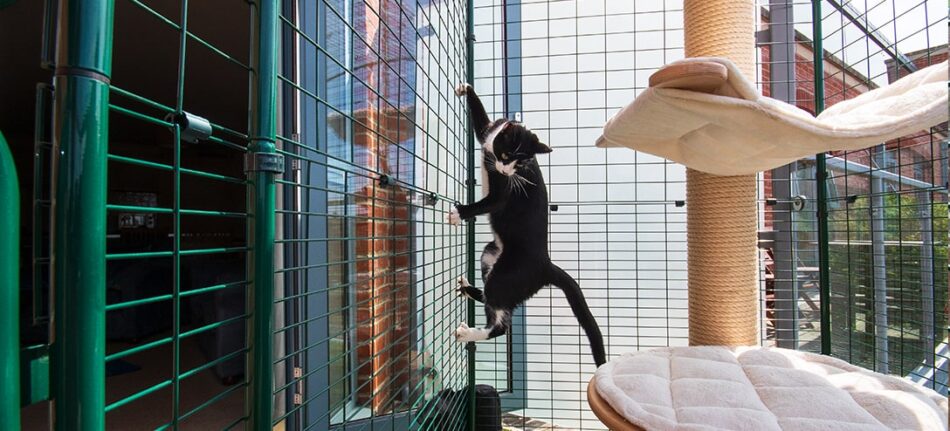
Why cat proof a balcony?
Before we look into cat-proofing options, let’s first explore why you want to create a cat safe balcony in the first place. If you live in an apartment or condo with a walk-out balcony, chances are you enjoy that outside space! Guess what? Your cat will enjoy it as well! But why do cats like to be outside?
Fresh air: We love to get outside to breathe in some fresh air and our furry feline friends are no different. A big dose of breezy clean air coupled with a shower of warm sunshine does anybody, or cat, good! Breathing in fresh oxygen stimulates the organs and blood vessels, providing for a healthier overall nervous system.
Stimulation: Think about the first things you do when you walk outside. You look, listen, and smell your immediate surroundings. Cats are the same way – only on a whole other level since their sense of smell is much more keen than humans! Being outside provides a cat’s senses with invaluable stimulation. They can watch cars driving by, or listen to birds singing in the trees, or just sniff away at the fragrance of flowers growing in the garden. Or, they may just do what cats often do best – sunbathe while taking a cat nap!
Exercise: Even if your cat gets plenty of playtime with their toys indoors, their minds and bodies are built to investigate the world around them. When a cat is able to explore a safely enclosed balcony, they can activate their innate exercise habits like jumping and running. And what better way for your active cat to stay vibrant and young than exploring and moving in a safely secured area!
Creating a safe balcony enclosure
The key to creating a safe outdoor space for your cat is security! Both you and your cat want reassurance that they can freely jump and play without the worry of falling off the edge of the balcony. So how do you make this happen?
The very first step in cat-proofing your balcony is to clear away any items that could potentially be harmful to your feline friend. Make sure none of these items are on your balcony:
- Plants: Cats can get bored and when they do, they often like to chew on anything they can find – including plants! However, some common household plants can be potentially toxic to cats. So in order to ensure your balcony is cat-friendly, take some time to familiarize yourself with which plants are safe for your feline friend, and remove the ones that are not safe from your balcony.
- Cords: Cats are quite curious by nature, so any time they see an item that is new and unfamiliar, they will likely use their sense of taste to first explore. Electrical cords can be very harmful to cats as chewing on them can cause burns inside their mouth. In fact, even unplugged cords can be potentially dangerous so it’s best to remove any and all cords from the balcony.
- Bug repellents, cleaners, etc: While bug sprays are efficient in helping to keep the annoying flying insects off of us, they can be quite harmful to cats. Most bug repellents have DEET as the main ingredient which has proven to be dangerous for cats if ingested. Likewise, many cleaning solutions contain ingredients that could cause issues for interested cats, so it’s best to eliminate them from the balcony altogether.
- Bird feeders: Even if you think your sweet, docile cat would never even hurt a fly, try putting them outside in an enclosed space with a bird feeder. You will likely reconsider! Don’t forget that cats are innate predators, so when given the chance to hunt an animal – especially a bird – they will likely take that opportunity every. single. time!
Making your patio a catio
When it comes to creating the ultimate cat haven for your feline friend, there are countless DIY tutorials on how you can create the space yourself. Sure…you can go to your local home improvement store and buy all the materials, but wouldn’t it just be easier to buy an enclosure that was already made for you? The Omlet product engineers thought so, too!
Introducing The Omlet Cat Balcony Enclosure! A securely designed, fully-enclosed catio that can fit any size balcony! We know that city life living can be difficult when trying to give your cat outside freedom, so we developed this escape proof enclosure with that in mind! Here are just a few of the many benefits you receive with the Cat Balcony Enclosure:
- Super sturdy! Built from strong steel mesh, this stylish cat enclosure is more secure than any DIY netting. We coated the entire enclosure in a dark green coating so it seamlessly blends in with your balcony and is unobtrusive to look at. The only DIY you will need with this product are additional metal fixings to secure the enclosure to your building for additional security.
- Sizes for all balconies! Available in 3 sizes, the Omlet Cat Balcony Enclosure can fit virtually any balcony from New York to Nevada! We designed each length (6ft. 9ft, or 12ft) with the same 3ft width so it was narrow enough to accommodate all standard balconies. In addition, the generously appointed height of almost 7ft allows your cat to explore all levels of the enclosure!
- Completely customizable! With the Cat Balcony Enclosure, the sky’s the limit on how you can customize your cat’s outdoor house! Add a cat tree for kitty’s claws, or a fabric shelf for lounging in the sun! You can even add a clear cover to the top of the enclosure so your cat can stay shaded and dry at all times! The options are endless when making and creating your cat’s ultimate catio!
Cat owners everywhere can agree that when it comes to our furry feline friends, we want to make their lives as enjoyable as they make ours. Giving your cat the ability to experience an enclosed balcony allows them the freedom to explore the outside world in a safe and secure manner. And just as fresh air and sunshine are psychologically beneficial for us, our cats reap the same rewards when given the exposure!

This entry was posted in Cats

When it comes to sleep, cats are the experts in this field. Often with the ability to sleep anywhere and in any position, cats are known for their love of slumber. But why do cats sleep so much? And how many hours of sleep a day do they really need? We have uncovered all the information you need to better understand your feline’s forty winks and why they may just have the paw on the pulse of pertinent sleep.
Why do cats sleep so much?
When it comes to sleep with any animal, two-legged or four-legged, there are a variety of different explanations for why so much sleep is needed. For cats, the best way to understand their sleep is to understand their biology.
By nature, cats are predators and are hard-wired as stalkers of prey. In order to quickly pounce and catch their food, they require quick bursts of energy to react. As a result, their bodies naturally seek quick, and often short, bursts of sleep to recharge.
While most felines spend the majority of their day in a snoozy state, only 25% of that time is actual deep sleep. The other 75% of the time they are in just a lightly rested state, or what we refer to as a “cat nap”. How can you tell which sleep state your cat is in? Next time your furry friend is snoozing on their super dreamy Maya Donut cat bed, check for any twitching of their ears. If you see movement, that means they’re likely in a rested, but not deep sleep. You can take a cat out of the wild, but you cannot take the wild instinct out of the cat.
So while cats may seem to sleep a lot, they usually never get it all in one stretch. Instead, they naturally opt for short 30-100 minute snooze breaks where they can rest their mind and bodies until the next burst of energy.
How many hours do cats sleep?
On average, most adult cats will sleep anywhere from 13-16 hours a day, with some only catching 10 hours of zzzs and others logging a total of 20 hours. While age, health, and disposition are key factors in a cat’s sleep habits, any cat owner will tell you that most cats sleep throughout the day. And often the night, too.
Kitten sleep
As tiny feline furballs, kittens average more sleep than the average adult cat. Why so much slumber? Kittens, like babies, are growing and learning at an exponential rate in their early stages of life. With such a rapid intake of information, sleep is an essential part of their development to process and grow. On average, most kittens can sleep 16-20 hours a day and this is completely normal. Just know that with every kitty cat nap, a frenzy of furball play will follow.
Adult cat sleep
By the time your kitten has reached maturity, which is usually around 18 months, they will have established a more regular sleep schedule. Most adult cats can sleep anywhere between 12-20 hours a day with short and abbreviated naps all day long. In the wild, cats tend to sleep all day and hunt all night. However, as man has domesticated our furry felines, they have adapted and learned to adopt new sleep patterns. So while you may still have a cat that likes to play at night, most adult cats will split their sleeping equally between day and night.
Senior cats
Just like humans, as cats get older, their sleep tends to get longer. Their bodies and metabolism slow down, requiring less outbursts of energy. Depending on breed, older cats are considered “senior” when they reach about 12-14 years of age. By this stage in their life, they may be logging up to 20 hours of sleep in a 24-hour period. This is completely normal. If, however, you do notice your senior cat’s sleep behaviors – like discomfort or unusual movement while sleeping – change, then consult with your veterinarian to make sure there is nothing else going on.
Which cat breeds like to sleep the most?
If you are looking for a lazy lap lounger to binge Netflix with you all day, you’re in luck. While all cats like to sleep, there are some that relish in the sweetness of slumber more than others. Let’s take a look at which cat breeds like to sleep the most:
Ragdoll: If given the chance to play with catnip or relax into a cat nap, the Ragdoll cat breed would choose the latter every time. This easy-going professional napper is also super affectionate and can fall asleep in any position. In fact, they have been known to ‘go limp’ in your arms when you pick them up, hence how they received their name.
Maine Coon: Known as the “gentle giant”, Maine Coon cats are the ultimate cuddling cat companions. Despite being large and long, this breed loves a snuggle session better than most and is happy to keep you warm on your couch both day and night.
Persian: What has long hair and could sleep all day long? Persians. If sleeping were an Olympic sport, the Persian would win gold. This breed is known as the relaxation expert so if you are seeking a sleeping companion, look no further than the Persian.
Just remember that with these cat breeds, because they prefer sleep more than most, that having lots of playtimes and cat toys is essential. Yes, sleep is beneficial for their health, but too much of any one thing isn’t good, so be sure to keep them active when awake.
Impacts on a cat’s sleep and how to encourage better habits
Most domesticated animals will start to adopt the sleep/awake patterns of their owners over time. Cats are no exception. While they do sleep more than humans on any given day, they can be just as affected by external influences as we are. We have compiled a list of some factors that could impact your cat’s sleep and offered some ways to encourage a better sleeping environment.
The right cat bed
When it comes to finding a bed for your cat, choosing something they’d rather rest on than your own bed can seem like a mission impossible. An uncomfortable, unsupportive bed is a recipe for a restless night for both you and your cat who decides to curl up on your covers instead. This is where the Omlet product designers step in. Meet the Maya Donut cat bed – a cat bed so luxurious it feels like a warm hug with every snooze. With a supportive shape and deep filling, the bed provides first-class comfort for cats, with a calming effect for anxious felines. Made with a faux fur material, the super soft feel of the bed is irresistible for any four-legged friend. Plus, you’ll sleep easy too, knowing that your cat is nestled up in the bed of their dreams.
Light
Whether artificial or natural, too much light for a cat can be a bad thing. In the wild, cats will seek out covered den-like areas to catch some quick zzzs. That innate trait stays with them, even in domestication. So having a darker sleeping environment is crucial to your cat’s sleep.
Just like we humans can’t sleep with all the lights on or when the sun is at high noon, neither can our feline friends. So try and create a room or space in your house that your cat can retreat to in order to get their beloved slumber. The Omlet Maya indoor cat house is the perfect option as it provides your cat with the secluded sanctuary they desire. Plus, the Maya Donut cat bed fits in perfectly with the cat house, creating the perfect cozy getaway space.
Active owners
Monkey see, monkey do! Or in the case of your cats, feline see, feline do! Even though cats are solitary animals who can easily enjoy a solo life, they usually can’t help but be impacted by the lifestyle of their respective owners. Especially in the last few years as people have rearranged their work habits to include more time spent at home, this impact is felt fully by your feline friends.
Most cats can sleep anywhere, at any time. However, if you, their owner, are constantly moving about the house and making disruptive noises, your cat’s sleep will be impacted. So while you may not be able to change your habits, you can help adjust your cats by giving them more spots and places to seek solitude. Consider the Freestyle Indoor Cat Tree where you can customize the ultimate “active to sleep retreat” for your cat.
Change in diet
Have you ever had a big greasy meal for dinner only to find yourself in a restless night’s sleep later? Cats can feel the same way whenever their food is changed or adjusted. When we start to feel lazy or like we may be putting on some extra weight, we have a tendency to reduce the amount of food we eat. And all too often, pet parents will make the same mistake with their cats. They think that because their cat is sleeping all day, it certainly can’t be burning off all the food it ate. So perhaps a reduction in their amount of food is the right idea? Wrong!
A quick reduction in your cat’s food intake will quickly result in a negative impact on their sleep. Before making any changes to your cat’s diet, always first consult with your veterinarian. And no matter how much you feed them, make sure your cat has a clean and sturdy cat food bowl to eat and drink from.
Omlet and your cat’s sleep
Omlet knows the importance of a cat’s sleep, which is why we made products like the Maya Donut cat bed and Maya Indoor cat house. So, next time your cat is sprawled out on the sofa in yet another siesta, try to appreciate their ease of life. Grab a blanket, curl up next to them and enjoy a quick cat nap.


This entry was posted in Cats

What has four paws, endless energy, and acts like a toddler? If you answered “a kitten”, you are correct!
Being a cat parent is a true joy! But have you ever raised a kitten? Do you know the different preparations and expectations that come with parenting a feline furball? We have sorted through the tips and tricks to provide you with the best knowledge on how to successfully raise a kitten!
Preparation
Kittens are born with their eyes still closed and an unregulated body temperature. Therefore, it’s important that they stay with their mother for at least the first 8 weeks of life to get their basic life needs met. When looking to bring a new kitten home, this allows you plenty of “prep” time to get everything set up in your home so your new kitty will adjust well!
The first thing you need to do is identify a room in your home that will be the designated “safe room” for your kitten. If you have ever raised a two year old human, you know all too well what life is like with a kitten – they get into EVERYTHING! The safe room should be somewhere that all potentially toxic items have been removed (i.e. plants, food, etc.), electrical cords have been put away, and unfamiliar dangers are eliminated. Once this room is set up you can start filling this space with all your kitten essentials!
New kitten checklist
Just like human babies, kittens require a lot of “stuff” in the early stages of life! Not only for their basic life needs, but for the development of their curiosity, personality, and engagement with others. Here are a few of the “must-have” items you need when raising a kitten:
- Food and water: Like babies, kittens require a specialized diet in the first few weeks of life – food that is formulated just for kittens and is highly digestible for their still developing bodies. The Omlet Maya Cat Bowl is a great item to have for their food and water as it is virtually untippable and environmentally safe to eat from!
- Litter box: Training a kitten to use a litter box early on will save you from unnecessary sprays later. Where you train your kitten to use the bathroom initially is where they will continue to go, so try and invest in a litter box option that can grow with your feline. The Omlet Maya Cat Litter Box is the prrr-fect option as it not only provides privacy, but doubles as a stylish piece of furniture as well!
- Indoor cat tree: Out in the wild, cats use trees for various reasons: to climb and check out their surroundings, to escape and feel safe, and to scratch their claws for comfort. Having an indoor cat tree for your kitten is not only essential for their innate understanding of life, but for their fun and happiness, too! The Freestyle Indoor Cat Tree is your one stop tree for all your kitten (and cat!) needs! Completely customizable with baskets and scratchers, this is the last cat tree you will ever need to buy!
- Toys: Kittens have a one-track mind in their early weeks of life: play, play, play! So the more toys you can have on hand to engage and entertain their playful minds, the better!
- Cat bed: All cats like a good cat nap – especially kittens who can log up to 20 hours of sleep in one day! And because most cats like to sleep in a curled up, nested position, finding a good cat bed is essential! The Omlet Maya Donut Cat Bed comes with a removable and washable cover, making it the ideal solution for your kitten to sleep and rest as they truly desire! You can even customize the color and feet to make it the perfect addition to your den!
Bringing kitten home
Now that you have your kitten “safe room” set up with all your kitten essentials, it’s time to bring your feline furball home! When it comes to raising a kitten, slow and steady wins the race! Let’s take a look at what you can expect over the first few months of life with your new kitten:
8-11 weeks of age: Most breeders will keep kittens with their moms until 8 weeks of age, so at the time you bring them to your home, they will be at least 2 months old. During these first few weeks together, your kitten will still be growing developmentally and acquiring new motor skills. So be sure to do lots of interactive play! This will help to build the bond between you and your kitten and help them to establish boundaries.
2 months – 4 months: Kittens experience exponential growth during this time of life! Have you ever heard of the “terrible twos”? That’s kind of what you can expect at this stage! At this age, kittens have approximately three times the amount of energy as an adult cat. And if your kitten is the only four-legged animal in your house, then they consider YOU their playmate! So expect to be playing A LOT with them to help you build a bond!
4 months – 6 months: By this point, your kitten has reached adolescence. This is the best time to get them spayed or neutered and begin regular vet visits for check-ups. Kittens start to become more territorial at this stage of life, so be on the lookout for any spraying and marking of items and areas.
Kittens + companions
Whether you are a single kitten household or a family full of four-legged friends, there are certain best practices to follow when introducing your new feline to others! We have explored the expectations of raising a kitten solo, but what if you already have other cats or dogs or kids at home?
Multiple kittens
Raising a kitten can be loads of work and copious amounts of fun! But raising two kittens? It’s double the love! The best time to introduce your new kitten to a companion is when that companion is also a kitten. When they are young, kittens have not yet established a sense of hierarchy, so getting to know and understand life with a friend who is the same age is a bonus for both felines! Make sure both kittens get equal amounts of attention and play and a lasting bond is sure to follow!
Kitten and dog
While nature may suggest that cats and dogs don’t get along, we disagree! With a little bit of patience and a lot of preparation, you can absolutely raise a kitten alongside a dog. The main thing to consider when raising these two very different animals together is that the introductions need to take time. On average, it can take anywhere from 4 weeks to 6 months before cats and dogs are comfortably cohabitating. The key to this relationship? Patience and persistence!
Kitten and children
Who doesn’t love a tiny furry feline? Most kids do! But when is the best time to get a kitten when you have kids at home? It’s important to consider the age of your kids when also considering a kitten. No child under the age of 12 should be given full responsibility of raising a kitten, so be sure there is an adult who can attend to the main care of the cat!

What to avoid
Happy kittens grow into happy cats and providing the right environment for their upbringing is an essential factor to their disposition. Let’s take a look at the do’s and don’ts of raising a kitten:
DO – Create a safe room and environment where they can feel comfortable and secure.
DON’T – Isolate your kitten by themselves. They need lots of attention and affection in the early stages of life to better adapt as affectionate adult cats!
DO – Feed your kitten specific food to their growing needs and body requirements.
DON’T – Give your kitten human food! Not only will this be potentially harmful to their digestive systems, but it will also establish harmful boundaries around human food later in life.
DO – Let your cat explore the outside world beyond the confines of your established “‘safe room”.
DON’T – Let your kitten or your cat go outside unsupervised! Domesticated animals do not have the same innate predatory instincts as wild animals and, as a result, could be in danger if left outside unattended. Consider an outdoor cat enclosure as the perfect option to let your kitten (or several cats!) explore the outside without worry of safety!
DO – Have lots of patience when raising a kitten!
DON’T – Expect too much, too soon! Just like babies, raising a kitten takes time and patience. And it will be a reward worth waiting for!
Kittens are tiny angels with whiskers! They may take some time and a lot of responsibility to raise, but the fruits of your labor will be immeasurable. With the right amount of love, patience, and preparation, they will grow into big angels with longer whiskers! Happy tails!
This entry was posted in Cats

Unlike dogs, cats like to be by themselves. In fact, by nature, felines are solitary animals and are purr-fectly happy doing life solo! But what if you, the pet parent, like having lots of animals to love on? What if you are both a cat and a dog person? Just like human siblings, cats can learn to love a new companion!
When it comes to bringing new furry friends into your one cat house, it’s important to make sure you know the rules of engagement that will best suit every tail! With a little preparation and a lot of patience, you can have a friend for your feline that you will both love equally. Let’s explore the best ways to introduce your cat to a new pet!
Preparation
As any good cat owner knows, the best way to make your home feel comfortable to any feline is to “catify” it properly! Cats like to climb and scratch and have access to escape places so your home has to be “catified”, or transformed, to suit their needs. This means having indoor cat trees for exploration and a good cat house for solitary escape when needed.
Before bringing a new pet into your home, be sure you put all of your residents cat’s items in one location in the house so they have their own separate space. This includes all climbing structures and cat beds as well all toys, food, blankets, and even their litter box. Basically any item that is a scent soaker for your cat! This will allow you to have a “basecamp” for your cat as you slowly make introductions.
A new cat friend
Some people say that cats are like spoonfuls of ice cream – you can’t have just one! There are millions of homes around the globe with two or more cats living happily together, so you, too, can do the same! Here are a few tips to help make that initial meeting and lifetime together harmonious:
Tip 1: The number one rule to remember when introducing two cats is to not let them meet face to face right away! Cats are not only solitary beings, but territorial as well, and meeting by scent only at first will better help with adjustments. Set up a separate area of your home – a guest room, office, etc. – that will be initially dedicated as the “new cat’s” home. Put all of their climbing trees, food, water, toys and litter box inside this space so it is completely separate from your resident cat.
Tip 2: After 2-3 days of bringing your new feline home, switch the “basecamp” spaces that each cat is in. If your resident cat was staying in the guest bedroom and the new cat was in the office, swap their “stuff” from one room to the other and have them stay the next 2-3 days in the new room. This will allow both cats to “get to know each other” through their respective scents before they actually meet.
Tip 3: On average, it can take a full week or more to gradually ease into the introduction process. Once both cats have successfully sniffed one another’s scents, it’s time for the official meet and greet. We suggest putting up a gate to block space between the cats for the initial meeting. With the resident cat on one side of the gate and your new feline friend on the other, slowly allow them to meet. Be sure to have treats for each of them to reward and encourage good behavior and toys for them to play with! You can repeat this step several times over the course of a few days with the goal of getting the cats to eat their food on either side while not being too bothered by each other.
Tip 4: After several “meets” with a barrier between them, the goal is to make sure that neither your resident cat nor your new cat are showing any signs of aggression. This process could take a few weeks up to a few months depending on the disposition of each cat. Keep in mind that if your new feline friend is a kitten, this process can take a bit longer. Kittens have lots of energy and if your resident cat is older, they may respectively need more time to adjust!
Your patience and persistence will pay off! Now you can open up the space and allow for both cats to mingle together without restrictions! Congratulations – you are now a multiple cat parent!
A new dog friend
You know the saying, “they fight like cats and dogs”? We think this notion is a myth! While canines and felines are not naturally the best of friends, they can absolutely co-exist together in perfect harmony! If you own a cat and want to introduce a new dog to the mix, the steps to do so are not that different from introducing a new cat. Be sure to follow the previous tips and consider these as well:
- When you do a first face-to-face with your new dog and resident cat, make sure your cat is at the dog’s eye level. This will help level the playing, or size difference, field between the two animals!
- Have a family member or friend hold the cat while you hold the dog to ensure safety for both should either animal show aggression.
- Limit alone time together until you feel completely comfortable that both animals are able to coexist without issue.
- The goal in a cat and dog relationship is toleration – not necessarily affection. So if both animals ignore one another consider that a sign of success!

Signs of success
As with any sibling relationship, there will be growing pains and wins along the way! While there is no magic formula that will guarantee a successful loving relationship between your cat and their new friend, there are a few signs to look for!
Adult current cat + adult new cat
If both your resident cat and new cat are adults, their bond could be immediate or could take months. The best way to have a successful older cat relationship? Make sure you really know the demeanor of your current cat before deciding on which new cat to bring home. If your resident cat is a snuggler and lazy lap lounger, you want to try to make sure the new cat fits the same personality. Knowing their key behavior traits beforehand will better provide for success sooner. You will know the two are happy housemates when they can co-exist in the same space without showing any signs of aggression!
Adult current cat + kitten
Kittens are energy furballs in motion! If your resident cat is of adult age, they may take some more time to warm up to the idea of a younger playmate. It’s a natural order for felines to want to establish hierarchy with other cats, so don’t be surprised if your once docile cat starts to hiss and swat at the new kitty. This is normal at first and should be tolerated as long as no felines are hurt in the process! A successful cat and kitten relationship can be found when boundaries are established and both cats understand them.
Adult current cat + dog
It’s true! Cats and dogs can in fact be best friends! While this is more of an exception than a rule, we have uncovered above the necessary preparations to make this relationship work well! The most important thing to remember when having both a cat and a dog in the house is that separate spaces are a successful key to this relationship! Once you have spent the time to make sure they can be around one another without aggression, be sure to always separate them to their individual spaces when unattended. Both your cat and your dog will appreciate this!
Essential products
There are many ways to make a house a home and for felines, there are many products that make them feel at home, too! Here is a list of the essential “must have” cat products you need to have for both your current cat and new cat:
Cat tree
Cat Tree: Cats like to scratch – A LOT! So having a place where they can sink their claws into is essential – especially if you want to keep your couches scratch free! In addition, a cat tree affords your cat the ability to climb up high to escape the dog when it may become too annoying! The Omlet Freestyle Indoor Cat Tree is a great option as it is completely customizable! Available in 6 sizes with a variety of accessories to choose from, this cat tree can easily accommodate all of your felines!
Outdoor cat enclosure
If you have a backyard space, consider an outdoor cat enclosure that will allow your cat to enjoy the freedom of being in nature without concern of wandering off. Bonus – the Omlet Outdoor Catio can be used by multiple cats at once! Simply install a cat enclosure partition to allow both cats the same freedom to roam, but with independent spaces! And if you lack a backyard – don’t worry! Omlet’s Cat Balcony Enclosure provides the same fully secure and escape proof experience!
Cat beds
We have the saying “cat nap” for a reason – cats love a good snooze! When owning multiple cats, be sure you have a bed for every feline because they don’t like to share! The Maya Donut Elevated Cat Bed is a great option with its customizable fabrics and machine washable capabilities!
Litter box
The biggest difference between cats and dogs? Where they go to the bathroom! And just like cat beds, you need to have at least one litter box for each cat in your house. Since cats like privacy when they are using “the loo”, consider the Maya Cat Litter Box that doubles as a sleek piece of furniture while also providing privacy! This customizable litter box design also helps minimize smells and messes!
When it comes to owning more than one cat, the keys to success are simple: preparation, persistence, and patience! Your resident cat may not know that they want a new sibling right away, but with a little bit of time and a whole lot of love, they will likely be cuddling with their new companion in no time! Happy tails!

This entry was posted in Cats
Your feline may be furtastic in every way, but can it jump the length of a giraffe’s neck? Or purr as loud as a vacuum cleaner? Earlier this month we explored the extraordinary canines who are world record dogs and now it’s the kitty’s turn to show off. Prepare to be wowed by these incredible cats and the Guinness World Records they hold.
Longest cat
Up first is Mymains Stewart Gilligan who holds the Guinness World Record as the longest cat. Coming in at a lengthy 48 in, this Maine Coon cat, who you can call Stewie for short, was as long as most 7 year old children. Hailing from Reno, NV, Stewie was a certified therapy animal whose owner, Robin Hendrickson, took her 4ft friend everywhere.
Taking care of all that hair on a cat this length will require proper health and hygiene. And if your feline is as long as Stewie, you may need a bigger bathtub!
Shortest cat
From longest to shortest, the world record holder for being purrfectly pint size is one of the world’s smallest cat breeds. Lilieput is a female munchkin cat from Napa, CA who stands 5.25 in. tall from floor to shoulder! To better understand this small stature, a US dollar bill is 6 in. long so Lilieput was shorter than that!
Christel Young, a professional pet sitter, adopted this pocket-sized puss as a stray. Initially, she said people referred to Lilieput as a “weirdo” because of her appearance. However, after receiving the Guinness World Record in 2013, those comments turned from cruel to kind. Who doesn’t love a tiny kitty?
Longest jump by a cat
Most cats land on their feet when they jump, but what if they are jumping the length of a king-sized mattress? The Guinness World Record for the longest jump by a cat was awarded in 2018 to Waffle the Warrior Cat with a whopping 7ft jump! And here’s the kicker – Waffle was 10 years old when he made this leap into the record books!
If you want your feline to beat this long feat, you will need to get a good indoor climbing cat tree for added practice. You can customize the Omlet cat tower to over 14ft tall so maybe your kitty can give Waffle a run for his catnip!

Cat with loudest purr
In 2015, Merlin, a rescue kitty from the United Kingdom, received the world record for the loudest purr – 67.8 decibels loud! To better understand in comparison, this mega-loud mouser can purr at the same level as a washing machine or vacuum cleaner. Owner Tracy Westwood said people often ask her “what’s that noise in the background?” when she is on the phone – only to find out it’s just her thundering tabby!
Most toes on a cat
The average cat has a total of 18 toes – 5 on each front paw, and 4 on both back paws. If you have visited Key West, you may have met some of the famous Hemingway cats who are unique with 6 toes on each paw.
But the world record holder for the most toes on a cat belongs to a 28 fingered – or toed – feline from Canada. Jake, a ginger tabby cat, was awarded this toe-tally pawsome world record in 2002 for having 7 toes on each paw! High seven, Jake!
Oldest cat ever to live
The Guinness World Record for the oldest cat ever to live goes to Creme Puff, a tabby cat from Texas. Born in 1967, this world record cat lived to be 38 years and 3 days old before passing away in 2005. That’s 168 years in human equivalence!
Owner, Jake Perry, said he kept his mature mouser healthy for so long by feeding her a diet of dry cat food, broccoli, eggs, and an eyedropper of red wine every two days! While this supposedly worked for Creme Puff, we aren’t surprised to hear that this type of diet has no veterinary backing. AKA – don’t try this at home, kids!
Longest cat whiskers
We know that whiskers play many important roles in a feline’s life, but does their length matter? For Missi the Maine Coon cat from Finland that answer is “yes”! This kitty not only holds the record for the longest cat whiskers at 7.5 in. long, but might also have the longest name, too! Missi is short for Fullmoon’s Miss American Pie – a suitable name for a notable record indeed!
Most tricks by a cat in one minute
If you thought teaching tricks to pets was reserved only for dogs, think again! In 2017, Didga the talented tabby set this world record by successfully completing 24 tricks with her owner, Robert Dollwet, in just 60 seconds.
This purr-fect kitty can not only sit, shake and rollover on command, but she can also jump over a stick while riding on a skateboard! Hailing from Australia, Didga (short for Didgeridoo), apparently loves to perform these impressive tricks for her favourite treat – raw kangaroo mince.
Longest domestic cat tail
Cygnus, the silver Maine Coon cat from Farmington Hills, MI, took home the Guinness World Record for longest tail on a domestic cat in 2017. Measuring a staggering 17.58 in. long, his tail was actually longer than his body length! Can you imagine walking around with a tail longer than you?
As rare as it is to have one cat world record holder, Cygnus shared his home, and the spotlight, with another record breaker! That’s right, owners Will and Lauren Powers, also owned Arcturus – the tallest cat record holder who measured 20 in. tall.

Largest domestic cat in the world
We saved the biggest, or best, for last! Ludo, a Maine Coon cat from the United Kingdom, holds the record for the largest domestic cat in the world with his 3ft 10.6 in length and 34 lb. body weight! To put that in perspective, Ludo weighed as much as a standard cinder block!
Owner Kelsey Gill knew early on that her favourite feline was pretty fantastic when he weighed in at 20.5 lbs before his first birthday! If you think your pretty kitty is a contender for this type of record, then a large outdoor cat enclosure would be perfect for them. This robust kitty play area is super spacious for cats of all sizes to roam easily!
We hope you enjoyed reading about these furtastic felines and their impressive Guinness World Records! For more information about cats of all kinds, be sure to check out the Omlet Cat Guide.
This entry was posted in Cats

Does your furry feline peacefully snuggle up next to you in bed or insist on sleeping on your pillow? Or do you have a designated spot for your cat to claim as their own, yet they still prefer the back of your sofa? There are pros and cons to sharing your bed with your cat, and even though a bit of bed-hopping might be fun, having your own place to rest your sleepy head can’t be a bad thing. In this article, we’ll explore some kitty-approved places and find out where to put a cat’s bed.
Your cat’s perfect bed
The Maya Donut cat bed offers the perfect place for your cat to relax, and with a plush, faux fur finish, it’s completely irresistible. Plus, its easy-to-clean removable cover means a hygienic home for you and a clean sheet feeling for your cat. It comes in a variety of beautiful colours to suit any boudoir, too. Choose to have it without feet so you can place it inside your Maya Indoor cat house – a modern and stylish piece of furniture that can be placed anywhere in the home. The cat house acts as a sheltered and cosy spot so your cat can snuggle up and have a peaceful snooze away from the hustle and bustle of a busy home.
Likewise, a few felines really like to rest high up, so for the more intrepid explorers, you may find your cat has more of a head for heights and likes to be well out of the way and off the ground. In this case, you can accommodate this personality with an incredibly versatile Freestyle floor to the ceiling cat tree. As a customisable piece, you can add whatever you want to make this a fun entertainment and napping zone all in the comfort of your own home.
Where to put a cat’s bed
Resting is a fundamental part of a feline’s life and they give plenty of time to it. Cats ordinarily pick their most loved snoozing spot(s) themselves and it can be challenging to encourage them to choose somewhere else. To expand the possibilities of your feline utilising the bed you have picked, you can at least ensure that it is set in a peaceful spot, away from any drafts. A warm spot, close to a radiator or in the sun, is typically great and should get the seal of approval.
Choosing to have your cat’s bed in a specific spot not only provides them with security, but also gives you peace of mind knowing that they are comfortable, and hopefully where they should be. That’s not to say that the odd sleepover in your bed won’t happen though!
So, where do you put a cat’s bed that ticks the boxes of these very selective customers?
Here are a couple of suggestions, recommended by cats for humans:
- On your bed (with or without you in it)
- On the window sill, preferably south-facing
- In the utility room when the tumble dryer is on
- In the laundry cupboard on nice warm towels
- Curled up on my snuggly Donut cat bed
- Occasionally on your laptop
How much sleep does a cat need?
How long a cat sleeps and how often will depend on the age and personality of the cat. They are renowned for having mid-morning or afternoon siestas or it may seem as though they just sleep all day. Got a nice warm spot by the window? Then you’ll most likely find your cat there. Warmth and quiet are key to blissful nap time. Cats on average spend 12-16 hours per day snoozing, so that spot has to be right. Most of us envy cats who always seem to find the most comfortable place in the house and can sleep most of the day, and while we’re working or doing chores our cats always find time to enjoy a peaceful slumber. Cats can grow irritable and restless if they don’t get enough sleep (a bit like their pet parents). This could be because their bed isn’t in the right place and they are not comfortable.
Sharing your space
Occasionally sharing your bed with your favourite snuggle puss is no crime! In fact, most cat owners will have done this once or twice. Cats definitely benefit from being close to their pet parent and the feeling is mutual. It secures a bond and provides companionship.
Most cat owners know that cats are more active at night, even though they love to snuggle up to you to start with. Once they’ve had enough sleep there is always a possibility that they will pounce when your foot twitches or will come and plonk themselves on your pillow right next to your head. Even though it’s adorable, it can lead to a sleepless night (for you).
Creating an area in your bedroom for your cat could be an option, so that if they do become a little more active or start fidgeting they can always relocate themselves to their luxury cat bed that’s so soft you’ll want to curl up on it yourself – ideal for the pampered puss.
Where not to put a cat bed
A cat will not be very forgiving if you place its bed in a cold or damp spot. You should also make sure that it’s away from potentially drafty windows or a particularly noisy spot. For example, if your living room or kitchen faces a high-traffic zone, then this will not be favourable to your kitty and they will most likely seek out somewhere more quiet to rest.
Don’t shut them away
You may have a house full of pets, children or antique furniture in which case you might be tempted to shut away your cat at night. This isn’t recommended, given that they are most active at night, this is valuable playtime for them. It doesn’t mean they should roam the house completely rogue, but allowing them some space to explore is important to their development and ultimately their happiness.
Omlet and your cat’s bed
Providing your cat with their own space is key to stability, space and a routine that your cat is happy with. Having favourite napping spots is perfectly okay and your cat will undoubtedly choose their own whether you like it or not, but knowing they can call a place a home of their own with the Maya Donut cat bed and Maya indoor cat house will make them perfectly happy and adjusted. A stable home environment is paramount to your cat’s happiness, you can read one of our recent blogs Why do cats run away? which outlines the importance of a peaceful and secure home environment.

This entry was posted in Cats














































